

How to Write a Character Bio (With Examples!)

If you’re starting a new roleplay (RP) or Tabletop Roleplaying Game (TTRPG), then one of the things you will be expected to provide is a character biography. If you aren’t familiar with writing character bios, then you might be a little stumped on what exactly needs to be included, and what is better left out.
Although there is no perfect, established way of writing a biography for a character, there are a couple of things you could do to make it more effective and useful to your fellow roleplayers and TTRPG players. But first, you should make sure you understand exactly what a character bio entails before writing your own.
This article is specifically about creating character bios for roleplays, tabletop games, and other collaborative writing settings. If you’re looking for how to create a character for a story, try checking out How to Make Characters Interesting, Complex, and Unique instead.
What is a Character Bio?
A character bio, also known as a character profile or character biography, is a brief overview of your character that you can provide to others prior to the start of a game or roleplay. It gives them an introduction to your character before the narrative actually begins, which makes it easier to create plots and interact between characters.
Generally, a character bio includes basic information about the character, such as their name, appearance, and behavior, but it can also include topics such as backstory and motivations. Bios can look different depending on what they are being used for, the genre of the story, and the other players’ preferences.
Why is a Character Bio Important?
Character bios make it much easier for other players or RP partners to get to know your character. By providing information on your character up front, you can allow others to get to know them, build relationships between characters, and come up with ideas for the story based around your character’s information.
In addition to that, having a good character bio can be helpful to reference later, especially if they are part of a long campaign. Bios help keep your characters consistent and true to their original design. Even the best writers forget things about their characters over time, so it’s a good idea to write everything down anyway. When I take notes on my characters, I usually keep the character’s bio at the top of the page and simply add to it as events unfold in the story.
How Long Should a Character Bio Be?
One of the most important things to keep in mind when writing a character bio is that it should be short . You need to keep it clear, concise, and brief. You aren’t trying to give away your character’s life story, after all. You just want to break the ice and introduce them to the other players and characters. After all, if you gave away all their secrets at the beginning, there wouldn’t be any mysteries to uncover over the course of the story.
As a general rule, you should try to keep your character bios shorter than a page (which is typically about 300-500 words). If you make it much shorter than that, you likely wouldn’t be doing your character justice. If you wrote much more than that, however, most people probably wouldn’t get around to reading the whole thing. Character bios aren’t exactly known for being riveting literature.
What to Include in a Character Bio
When you’re writing your character’s bio, you don’t need to create an entire novel about their life and exploits. You only need to include the details that are important for others to know from the beginning. Some things aren’t even important enough to share at all.
Although some people have preferences about the ways they want character bios to be formatted, this is the generally accepted formula for writing a good character bio.
The Most Basic Character Elements
The first thing you should establish in your character’s bio is the most basic elements of who they are. That includes things like their:
- Species (if applicable)
You don’t need to get fancy here. This is the easy part—just give the basic information and move on to the next section.
The Character’s Physical Description

Next, you’ll want to give a basic description of what the character looks like. For this section, you’ll want to consider their:
- Physical details
- Clothing style
You can cover this information in bullet points, but I find that it is much more effective to write this part in paragraph format. That makes the bio feel more like an introduction to the character, and less like some kind of legal document.
If you need some pointers for designing your character, check out Tricks for Describing a Character’s Appearance (With Examples) .
Remember to keep this part brief. Physical appearance is only one small part of a character, and you don’t want to waste too much time and energy describing what they look like—especially since you don’t want their bio to be too long.
The Character’s Personality
Obviously, most of the character’s personality should come out as you are playing them, but it’s still a good idea to give your RP partners or TTRPG players an indication of their personality before the game or RP begins.
As with the other sections, this part should be kept brief. You just want to cover the most important aspects of their personality. You know, the traits and behaviors that define who they are. That could be anything from “grumpy” or “hot-headed” to “innocent” or “creepy.” Just give a few adjectives to describe them, and describe some of their dominant behaviors. This section shouldn’t be any longer than a few sentences.
The Character’s Backstory
This section is the tricky part. You want to explain enough of your character’s backstory to explain how they got where they are in the present day, but you don’t want to give away too much and make your character a completely open book. Not only that, you want to make sure the information you are providing is meaningful to the story, and not just useless facts.
When summarizing the character’s backstory for their bio, you should cut out everything except for the bare bones. The details aren’t important now (and you can reveal more over the course of the story anyway). Instead, draw attention to a few milestones in the character’s life, whether that relates to family, education, tragedy, or something else.
What happened in their past to turn them into the person they are at the beginning of the story? Focus on those points, and leave out all the rest.
If your character doesn’t have much of a backstory yet, you might want to check out this article before moving on: How to Create Compelling Character Backstories .
What Motivates the Character
When you’re creating a bio for a character, you’ll want to consider their motivations and goals. A character without a direction is boring, so make sure you have some idea of what your character wants before the story begins. Do they want to start their own business? Hunt ghosts for a living? Avenge their dead brother? What is going to motivate your character to actually do something ?
This part of the bio is often labeled as “present day,” or it’s lumped in with the backstory section. Regardless of how you choose to format it, the point is worth drawing attention to by itself. This part is particularly important for RPs and TTRPGs because it gives partners and fellow players the context they need to understand how this character operates.
The Character’s Quirks and Flaws
I cannot stress this enough: every character needs to have flaws.
All characters need flaws. No one is perfect, so none of your characters should be either. Even if your character is perfect in one regard, they need to be flawed in some other way. The best sharpshooter in the world might be afraid of snakes. The world’s most mesmerizing dancer might have self-confidence issues.
Quirks are also important! They operate a lot like flaws, though they don’t interfere with the character’s ability to live their life normally. Having a weird sense of humor or a tendency to fidget isn’t necessarily flawed behavior, but it is worth mentioning in this section as well.
Flaws and quirks are indispensable when it comes to creating interesting characters. They create conflict, and make characters more realistic and sympathetic. Without those details, your characters just won’t resonate with other players. Or worse—you’ll get accused of creating a Mary Sue .
If you want more information on creating flaws for characters (and why they’re so important for stories), check out How to Create Complex Flaws for Characters .
Miscellaneous Traits and Abilities
Finally, you’ll probably want to include a miscellaneous category at the end of the bio. Depending on your personal preference and the genre of story you’re creating, this part could also go closer to the top. You could also use a different term, or include this category as part of the character’s basic info.
This is the section in which you include anything important that wasn’t covered in the other sections. This could include things such as the character’s:
- Magical Abilities
- Special Skills
- Languages known
Basically, this section is meant to cover anything else that your RP partners or TTRPG players need to know about your character.
What NOT to include in a Character Bio

That “miscellaneous” category probably has you scratching your head. If that’s supposed to cover the other important parts of your character, how do you know where to stop?
There are many things that you should never include in a character bio, but there are two distinct reasons why things should be left out: either the point is boring and doesn’t matter, or it is much more fun to reveal that particular piece of information over the course of the story instead.
Here are some things that should be left out of character bios because they are uninteresting :
- Their Zodiac sign
- Every single detail of their appearance or personality
- Their entire life story
- Their birthday
- Their entire family tree
- Their favorite food/color/etc
Here are the things that should be left out because they would make good plot points later :
- Their secrets
- Their relationships with other characters
- Their strengths and weaknesses
- Their past trauma or struggles
Character Bio Examples
Character bios don’t have to show off your best writing skills. The point isn’t to impress the pants off the other players, and it’s definitely not to prove you’re a better writer than anyone else. You aren’t showing off, you’re just providing a resource on your character that is necessary for the game or RP.
With that said, here are some examples of character bios to give you a better idea of how to apply all this information.
Sample Character Bio 1
Name: Rory Bannon
Sex/Gender: Male
Species: Human (Superhero)
Superpower: He can float.
Power Drawbacks: He’s not very good at controlling his ability, and it is dependent on his mood. Sometimes, he will begin to float when he gets excited.
Appearance: Rory is tall and lanky, and his limbs almost look too long for his body. He has brown hair with a stripe of orange in the front. He has a goofy smile, and he holds a lot of childish optimism in his sunny green eyes. He always wears a suit no matter where he goes, believing that dressing for success is the first step to achieving it.
Personality: He’s chipper and optimistic, and all his friends agree that he’s a bit of a hopeless romantic. He’s a dreamer, and his head is often stuck in the clouds.
Backstory: Rory is an only child from a loving home. He decided to attend a school for young heroes to learn how to control his powers, with the full support of his doting parents.
Goals: He wants to learn how to control his powers and use them to help others.
Quirks: He’s gotten pretty good at floating up—just not at coming back down again.
Sample Character Bio 2
Name: Alice Howard
Nicknames: Red, Little Red, Pumpkin (by her father)
Sex/Gender: Female
Appearance: Alice is the preppy, pretty girl at school, with a figure that makes boys drool. Her long hair is a gorgeous shade of reddish-brown, and delicate freckles dot her petite, pale features. She is careful to keep her makeup perfect, and she is always pushing the limits of what her school’s dress code allows.
Personality: Despite her looks, Alice is remarkably insecure. She thrives off compliments and bases her entire self-worth on what others think of her. One bad pimple is enough to get her to skip school, and she takes even the smallest insults to heart. Despite how she feels about beauty and her own self-image, she always tries to be uplifting and encouraging to other girls, and would never say anything nasty about the way someone looks.
Backstory: Alice lives with her grandparents since both of her parents are deployed Marines. Her grandparents are getting quite old, and they often require her help more often than she needs them. She does her best to be responsible, but she often regrets that she can’t get out as much as other girls her age.
Goals: Alice has a history of bad relationships. All she wants is a good boyfriend and real friends.
Quirks: She has a tendency to be clingy and physically affectionate with her friends.
Misc: Alice’s one true love is food, specifically greasy, tex-mex food.
Sample Character Bio 3

Name: Samson Anders
Nickname: Sams
Species: Half-human, half-demon
Height: 6’2”
Hair: Long, Brown
Eye Color: Hazel
Skin Color: Medium-light
Physical Details: He has a large scar over the left side of his neck and collarbone, and multiple smaller scars all over.
Personality: Harsh, cold, and unapproachable. He has a softer side for those he cares about.
Past: He isn’t one to talk about his past. Most of his friends know that he had a rough childhood, but no one knows the details.
Present: He is living with a friend in a one-bedroom apartment, and the duo are professional ghost hunters.
Goals: Secretly, he hopes to learn more about his demonic side.
Quirks/Flaws: He tends to grow out his facial hair when he is feeling down, simply because he can’t be bothered to shave.


The Best Original Character Bio Template (250+ Traits Info Sheet)
August 17, 2023
The best character template to help you include traits you would never consider. Even expert OC designers can't figure out all the details without some prompting!

Do you have an OC you’re making and want to build your character up? We got you covered!
There are many different approaches to character creation! Using a character sheet can help your character feel more well-rounded.
Even experienced character designers can't keep all the character details without some prompting! This original character template can help include key motivations, background info, and traits that you would never consider.

How To Use This Free Character Bio Sheet
Whether you're a pro or just starting out, this character info sheet will help you develop your character!
The best way to use this template is to start with the basics. Don't feel like you have to fill everything out. That's too much! The goal is to use these traits and prompts to brainstorm.
You can also post your OC to CharacterHub ! On CharacterHub, these prompts are built in. The tool helps you brainstorm and keep track of all your characters and worlds. Once you post your character, you can get feedback from the community, meet other OC creators, and share art and stories!
Original Character Sheet:
Basic info:.
- Gender/Pronouns
- Appearance (physical features, style, etc.)
- Personality (positive and negative traits)
Physical Traits + Appearance:
- Facial Hair
- Specific Features
- Facial Features
- Dominant Hand
- Teeth (straight, crooked, missing)
- Voice (pitch, pacing, etc.)
- Sense of fashion and style
- Health (disabilities, illnesses, conditions)
Other Characteristics
- Personality Type
- Cultural Background
- Speech Patterns
- Most Used Phrases/Words
- Habits (good and bad)
- Intelligence
- Education level
- Sense of humor
- Problem-solving skills
- Emotional Intelligence
- Introverted or extroverted?
- Political views
- Core Values
- Beliefs about morality and ethics
- Beliefs about happiness and success
- Beliefs about the world and society
- Stance on social issues
- Personal Philosophy
- Self-perception
- Optimism vs. Pessimism
Motivations:
- Darkest Secret
- Biggest Dream
- Deepest fear
- Inner Conflict
- External Conflict
- External Pressures
- Insecurities
- Worst nightmares

Relationships:
- Significant Other
- Family (and family dynamics)
- Co-workers/Professional Relationships
- Mentors/Mentees
- Past Romances
- Best Friends
- Close Friends
- Acquaintances
- Strained Relationships
- Supportive Relationships
- Toxic Relationships
- Role Models
- Most important relationship
- What do they like about their relationships?
- What do they wish could be improved about their relationships?
- Special Powers
- Supernatural Abilities
- Fighting Style
- Physical Strength/Endurance
- Persuasion Ability
- Survival Skills
- Spiritual Abilities
- Technology Skills
Entertainment:
- Online usernames
- Social Media Usage
- Technology Usage
- Followers/Following
- Favorite Apps
- Communities Apart Of
- Favorite forms of entertainment
- Favorite movies
- Favorite TV shows
- Favorite games
- Favorite book
- Favorite outdoor activities
- Celebrity Crush
- Comfort Food or Activity
Other Favorites
- Favorite food
- Favorite drink
- Favorite place
- Favorite animal
- Favorite color
- Favorite song
- Favorite band
- Favorite sports team
- Favorite brand
- Favorite store
- Favorite thing to do
- Favorite weather
- Favorite season
- Favorite mythical creature
- Favorite joke
Professional Traits:
- Income Level
- Volunteering
- Professional Goals
- Professional Reputation
- Career Challenges
- Professional Skills
- Feelings about job
- Feelings about co-workers
- Personal history (childhood, past events, etc.)
- Social class
- Criminal Record
- Notable life events
- Accomplishments
- Key Memories
- Childhood influences
- Major life decisions
- First Heartbreak
- Life Lessons
- Cherishable Moments
- Major Failures
- Most embarrassing moment
- Most meaningful possession
- Most difficult decision
Fandom (if the character lives in a fan universe):
- Is this character part of an existing fandom or universe?
- How does this character relate to the canon world?
- Are there any notable relationships to that universe?
- What special powers (if any) do they have from that universe?
- Have they influenced history in any way?
- Do they have any notable accomplishments within the universe?
- What are their roles and responsibilities?
Character Development Questions:
- How does your character handle conflict and difficult situations?
- How does your character relate to others and form relationships?
- How do your character's personality and actions change in different environments and social circles?
- How did your character's childhood shape their personality and worldview?
- How does your character cope with their emotions and vulnerabilities?
- Why does your character make the choices they do and what motivates them?
- How has your character's personality changed over the years?
- How does your character handle success or achievement?
- If your character could have any superpower, what would it be and why?
- If your character could travel through time, where and when would they go?
- If your character could have any famous person as their mentor or role model, who would they choose and why?
- If your character could have any one wish granted, what would it be and why?
Roleplay Details (for a character roleplay bio):
- Types of characters this character interacts best with
- How the character’s personality ideally evolves in a roleplay
- Roleplay role (is this character typically a protagonist? Antagonist? Supporting character?)
- Common starters: prompts or starter stories that fit this character well
Other Character Bio Creation Tips:
- Write journal entries as your characters. This helps you think as your character, making them feel more realistic. The Posts function on CharacterHub is good for this.
- Map out your character arc. Characters need to develop over the course of your story! After filling out these details, outline what the character learns and the emotional development the character goes through.
- Practice writing about your character . Pick another character in your universe. Write about them as another character to get a more comprehensive view of the character. Answering writing prompts can help you brainstorm.
- Use the character template even if you won’t utilize all the traits . Knowing everything about a character helps them feel more real, regardless of if you ever use specific details. The information from the character info sheet can slightly alter how they react, respond, or behave in ways that aren’t tangible.
Creating Characters on CharacterHub
No need to store your OC Character Sheets in Google Doc anymore! CharacterHub provides simple tools to help you brainstorm and keep track of all your characters and worlds! Post characters, build an audience, get fan art, and store everything. You can find it all on CharacterHub ! It like combining all reference sheets, notes, templates and character info sheets into one!

Table of Contents
Share on social, unlock your character's full potential, join characterhub for exclusive access to revolutionary character-building tools and a like-minded community.

OC Drawing: Step By Step Instructions on How to Draw an OC

How To Make Character Concept Art: A Guide To Developing Character Designs

How To Design Clothing, Fashion, and Costumes For Your Character: With Outfit Ideas!
Become a Bestseller
Follow our 5-step publishing path.
Fundamentals of Fiction & Story
Bring your story to life with a proven plan.
Market Your Book
Learn how to sell more copies.
Edit Your Book
Get professional editing support.
Author Advantage Accelerator Nonfiction
Grow your business, authority, and income.
Author Advantage Accelerator Fiction
Become a full-time fiction author.
Author Accelerator Elite
Take the fast-track to publishing success.
Take the Quiz
Let us pair you with the right fit.
Free Copy of Published.
Book title generator, nonfiction outline template, writing software quiz, book royalties calculator.
Learn how to write your book
Learn how to edit your book
Learn how to self-publish your book
Learn how to sell more books
Learn how to grow your business
Learn about self-help books
Learn about nonfiction writing
Learn about fiction writing
How to Get An ISBN Number
A Beginner’s Guide to Self-Publishing
How Much Do Self-Published Authors Make on Amazon?
Book Template: 9 Free Layouts
How to Write a Book in 12 Steps
The 15 Best Book Writing Software Tools
The Ultimate Character Bio Template: 200 Character Development Questions
POSTED ON Feb 6, 2024
Written by Hunter Freeman
A character bio template is a shortcut for developing realistic characters. It's the key to creating believable protagonists and antagonists that come alive through your writing. Character bio templates include guiding questions to help you shape your main characters as you write.
*** Remember, writing great fiction starts with writing great characters!***
By answering significant questions about your character's development, not only will you be able to understand a character inside and out, but you’ll also be able to show your readers the depth of your character.
Creating life-like characters goes beyond just plopping your character into the storyline, giving them a name, and describing a few traits.
And it’s not just for fiction – but for non-fiction , too. Are you writing a memoir? A biography? A self-help book using “case studies” or examples of people in particular situations? Experimenting with creative writing prompts ?
You’ll want to fill out a character bio template for your main character if you’re writing one of these non-fiction books as well!
Even if your character is modeled after a real person, that’s not enough to make him or her come alive for the reader. As an aspiring author , the first rule of thumb is to fully develop your character. You need to create an individual with a story of their own that readers want to engage and connect with as they read your book.
Your character’s development should not be an afterthought – after all, you’re telling a story, and the story likely centers around the characters.
Invest the time to answer these questions in our character bio template, and you’ll see just how real your character will become.
Get The Free Character Sheet!
Unlock Your Character's Full Potential with Our Free Character Sheet.
This blog on character bios will cover:
What is a character bio.
A character bio is a document or template that outlines the biography of a character in a story. Commonly used in the form of a character sheet template, which includes in-depth questions that highlight the character's traits , descriptions, and journey, the character bio is used as a resource for the writer's reference.
A character bio template helps the writer keep track of the character's arc, background, and preferences which then helps the reader understand the character's dynamics through the story. By creating a character with a past, present, and future, storytellers are able to paint a vivid picture of the character's behavior and actions as displayed in the story.
The main goal of using a character profile template is to increase the realistic attributes of the character, to ultimately make them more believable and relatable for the reader.
Character bio templates are used mainly by fiction writers and authors, screenwriters, and other storytellers. Character profile templates should be filled out for all main characters in the story, including antagonists, to improve the overall character development.

Why is character development important?
Character development is important because the more developed a character is, the more realistic the character is – and readers want to invest in characters that are believable.
Have you ever been so connected to a book or story that you were devastated when you finished reading it? You were sad to say goodbye to the characters. You wished you could open up the portal to that world forever.
If you’ve experienced that, then you were emotionally invested in the characters and their lives. You connected with them – you felt like you truly knew them. And that’s because the writer did such a phenomenal job developing the character, that they seemed real to you as the reader.
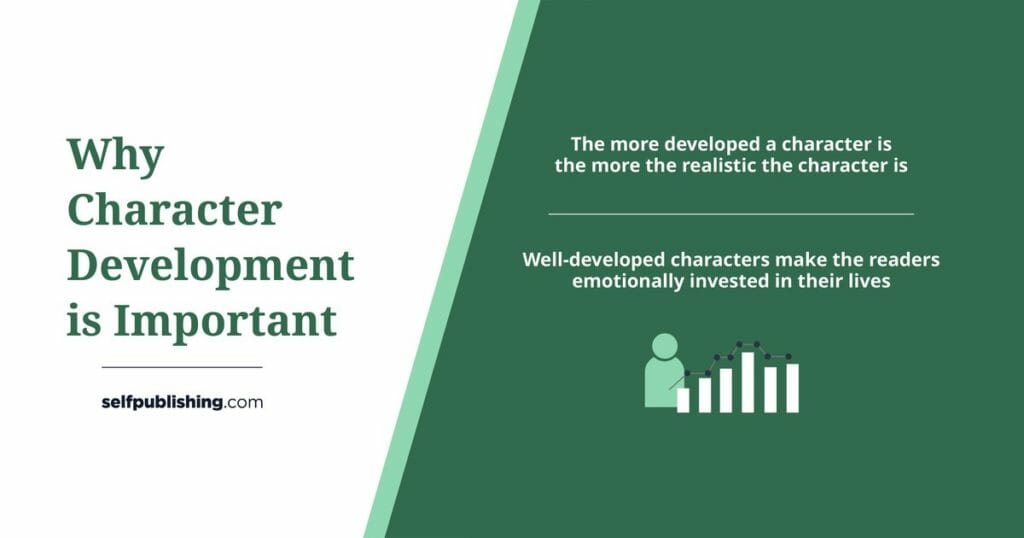
That’s exactly what you want to do with your own writing. You want to write characters that are so fully developed, the reader will become invested in their lives.
And the secret to fully developing characters lies in being able to answer detailed questions about your character, which is how this character bio template will help you.
Top character development tips to use when writing:
- Start with a mind map or outline of your character's journey in the story.
- Brainstorm the character's main characteristics as needed for the story's plot.
- Practice writing about your character to get a solid idea of who the character is.
- Give your character a main goal, purpose, motivation, and flaw.
- Fill out the character bio template to fill in any gaps and get clear on their history and small details.
- Interview your character to build their perspective.
- Complete writing exercises from your character's perspective to fully develop the character's mindset.
- Begin writing your story with your fully developed character in mind.
Why should you use a character bio template?
Using a character bio template will help you create realistic characters that your readers will believe in, and connect with.
You should develop a character bio to create believable characters for two reasons.
First, by answering character development questions in a character profile template, you’ll know the character like the back of your hand, which helps you tell your story better.
Second, the character sheet template will help you create an actual individual by painting a comprehensive, detailed picture of who they are – from what they look like to their personality quirks to their biggest mistakes in life.
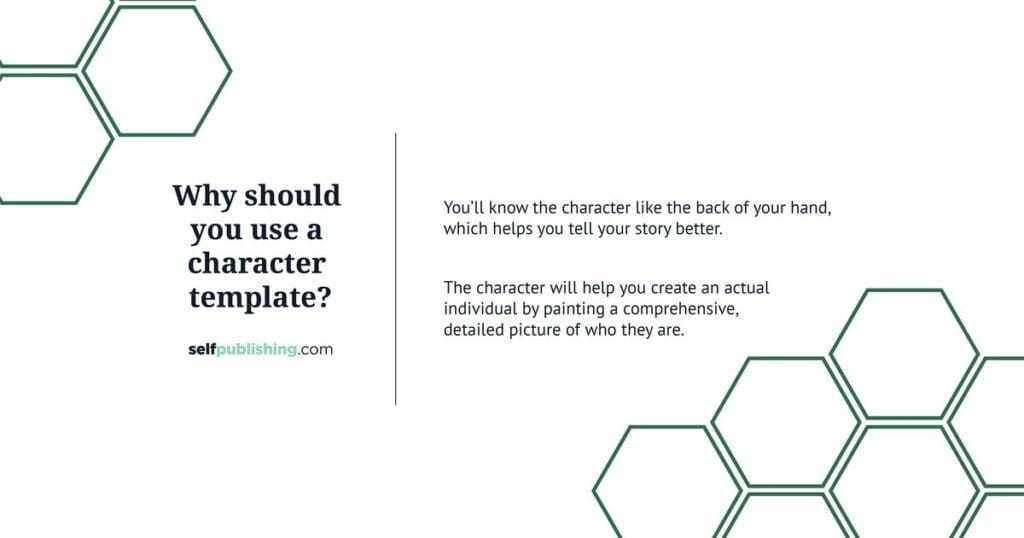
Reasons to use a character bio template:
- To help you tell your story better
- To prevent inconsistencies in details
- To create a life-like character, full of personality with a comprehensive living history
- To use as a reference when incorporating details about your character
- To improve your character's development
- To help readers connect and relate to your character
- To immerse your reader in your story
What should a character profile include?

A character profile template should include all of the relevant details that the writer needs to incorporate into the story, to fully develop the character.
Some writers use a basic character bio, with only relevant details that show the character's arc within the story, while other writers use an advanced, comprehensive character bio with specific details about the character's life, personality, aspirations, and internal and external features.
The type of character profile you include will depend on several factors, such as the type of work you are creating (ex: novel, short story, film), and the type of writer you are (ex: do you need a comprehensive profile, or just a one-page summary?). At a minimum, you should include the specific details about your character that highlight his or her role in the story, and how they develop within your story.
What to include in your character profile template:
- Character basics such as name and age
- Physical description of the character's appearance
- The personality traits of the character
- Overview of the character's health
- Career and education details
- Preferences and motivations of the character
- Description of the character's family life
- Overview of the character's main relationships
- Important life stages and milestones
- Character perspectives, outlook, and opinions
- Character's role in the story's development
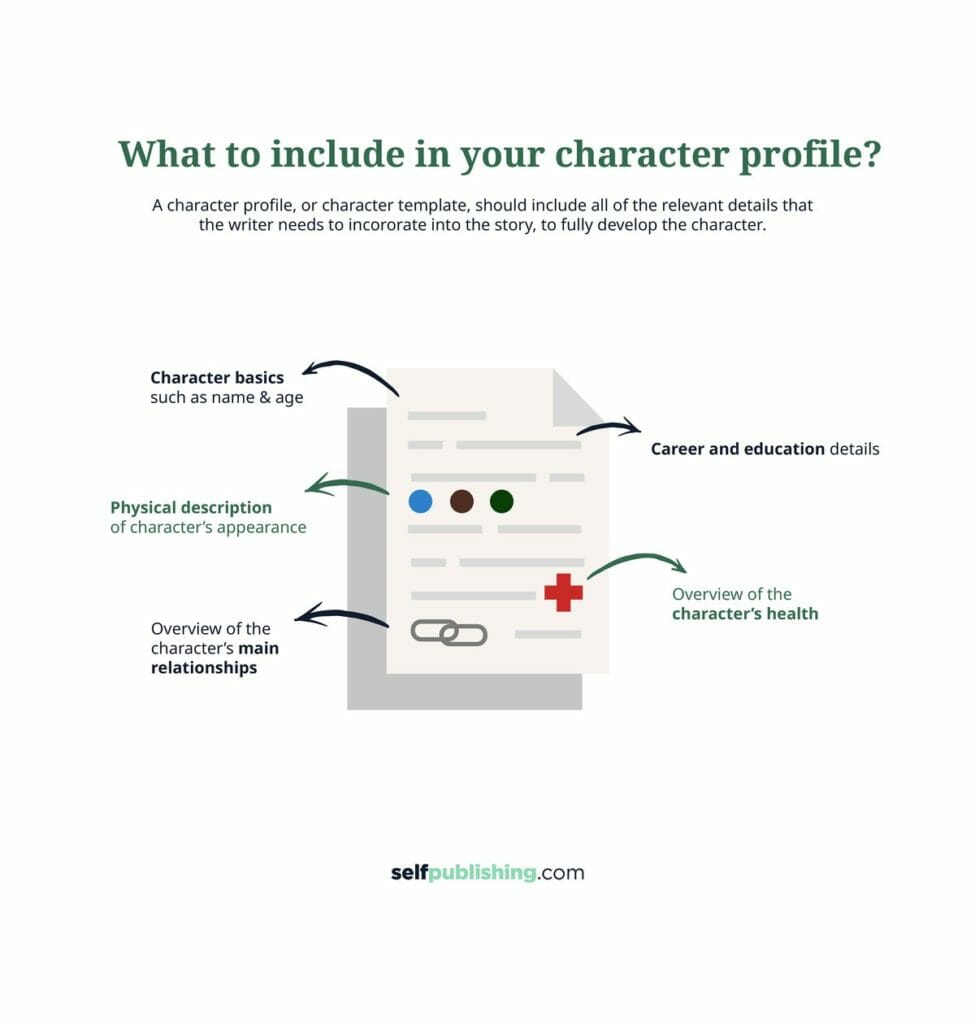
How to use this character bio template
This particular character bio template is comprehensive, and designed to be used as an in-depth resource with more advanced character development questions. Novel and short story writers will benefit from this character sheet template to create a full character bio.
Fill this template out fully for each of your main characters (protagonist and antagonist), and use the sheet as a reference for your writing.
Click here to jump to the Character Template!
It’s best to complete the character bio template once you have your story’s outline, but before you actually start writing your rough draft. If you’ve already started writing your rough draft, that’s okay – you can still use this character bio template and it will be helpful as you edit and complete your draft.
Read this article if you want to learn more about how to write a book outline .
How to use a character bio template to improve your character's development:
- Start with a good idea of your character's creation , like who they are and what their purpose is in your story.
- Know your character's flaws , motivation, main goal, and purpose.
- Begin filling out the basic section in your character bio template.
- Get clear on the physical descriptors of your character.
- Fill out health section of the character bio template.
- Next, build out your character's career details .
- Think about what your character prefers .
- Dig into the family history in the character's bio.
- Then, move on to the relationships section of the template.
- Narrow down your character's main life stages .
- Develop the character's perspectives and views of the world.
- Next, build the character's story development .
- Review the full character bio template to make sure every detail connects, and that there are not any inconsistencies.
- Practice writing from your character's perspective to get a natural feel for the way your character thinks and acts.
- Practice writing about your character from different perspectives (as a narrator, as a friend/lover/enemy of the character).
- Repeat all the above steps for any major characters in your story.
- Reference your completed character bio template as you begin writing.
Following the tips above will help you to develop a realistic character that readers will be invested in.
Don’t just share this character bio template directly with your reader – it is meant to be a complete guide for you as you write about who your character is, and how he or she affects the story.
This character bio template serves as a skeleton for developing a realistic character, so you should be able to answer each question. You need to be able to answer everything about your character, but your reader only needs to know the details that help tell the story.
These character development questions are comprehensive, so this doesn’t mean you need to tell your reader everything about your character. Only give your reader what they need to know about your character as it pertains to your story.
If you’re writing a genre or story that requires more questions, feel free to add more as you see fit! For example, if you’re writing a sci-fi novel, maybe you need to answer more questions about your character’s species, or the special powers that they possess.
As you write, you’ll want to have a copy of your completed character bio template nearby so it can be retrieved easily and referenced. This will help you tell your story more accurately, by avoiding little mistakes or inconsistencies in your plot and story setting .
For example, let’s say you start the story by describing your character as a vegetarian, but later on have your character order a hamburger at a restaurant. This is a detail that many engaged readers will notice!
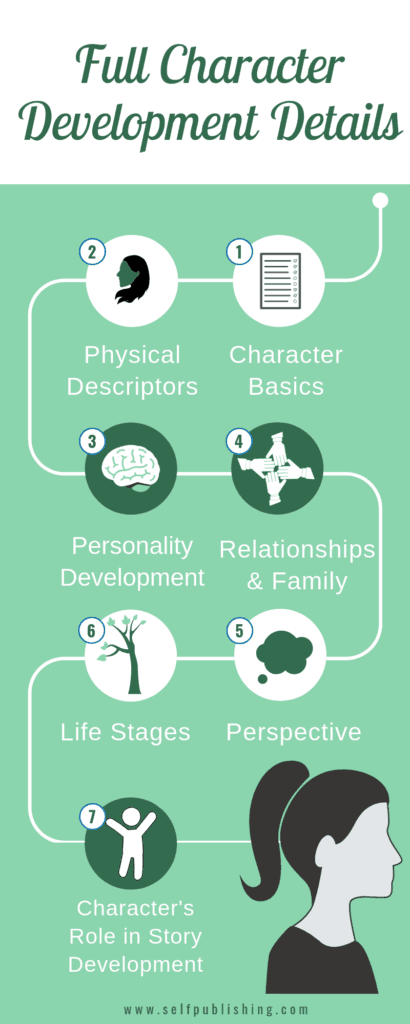
Tips for using this character bio template in your writing:
- Complete the character bio after your outline is completed. Start filling out the character bio sheet after you complete your story outline , but before you start fully writing your chapters. This will ensure you have a solid idea of what details make sense based on your story's main events, but still gives you the opportunity to incorporate the small details into your actual story.
- Use the character template as a reference guide when writing. Don't just fill out the template and share it with your readers. This exercise is meant for you, as the author, so that you can fully develop all the intricacies of your character, and incorporate relevant details to shape who your character is, and their purpose in the story.
- Don't skip any questions that can be answered. Answer as many questions about your character as possible. Obviously, if a question does not apply to your character (like if they are a child and do not have any past relationships), skip it. But don't avoid questions simply because you don't want to think. Cutting corners in this way will reflect in your character's development.
- Only give your reader what they need to know when you're writing. Just because you answer every question in the character development sheet, doesn't mean that your reader needs to know all of those details. Only give what's necessary, and what will help your reader understand your character better.
- Add more questions as needed. This character bio template is meant to be a starting point for you. If you need to add more questions, do so, especially if you're writing a genre like hard science fiction where your characters are non-human.
- Think about the small details. Once you start writing, the character bio template will bring value to your dialogue , scene setting, and plot. Don't be afraid to focus on the small details.

200 questions for your character bio template
Here are the questions you should answer about your character in order to bring them to life:
Character bio template basics
Begin by answering these basic questions about your character. These character development questions are the surface-level facts that you can use to start building your character.
These are the essential facts to fill out for your character, such as name, birthday, race, gender, etc. This section should be particularly quick for you to fill out since you most likely know all of these details for your character already. These questions help show your character's development on a surface level.
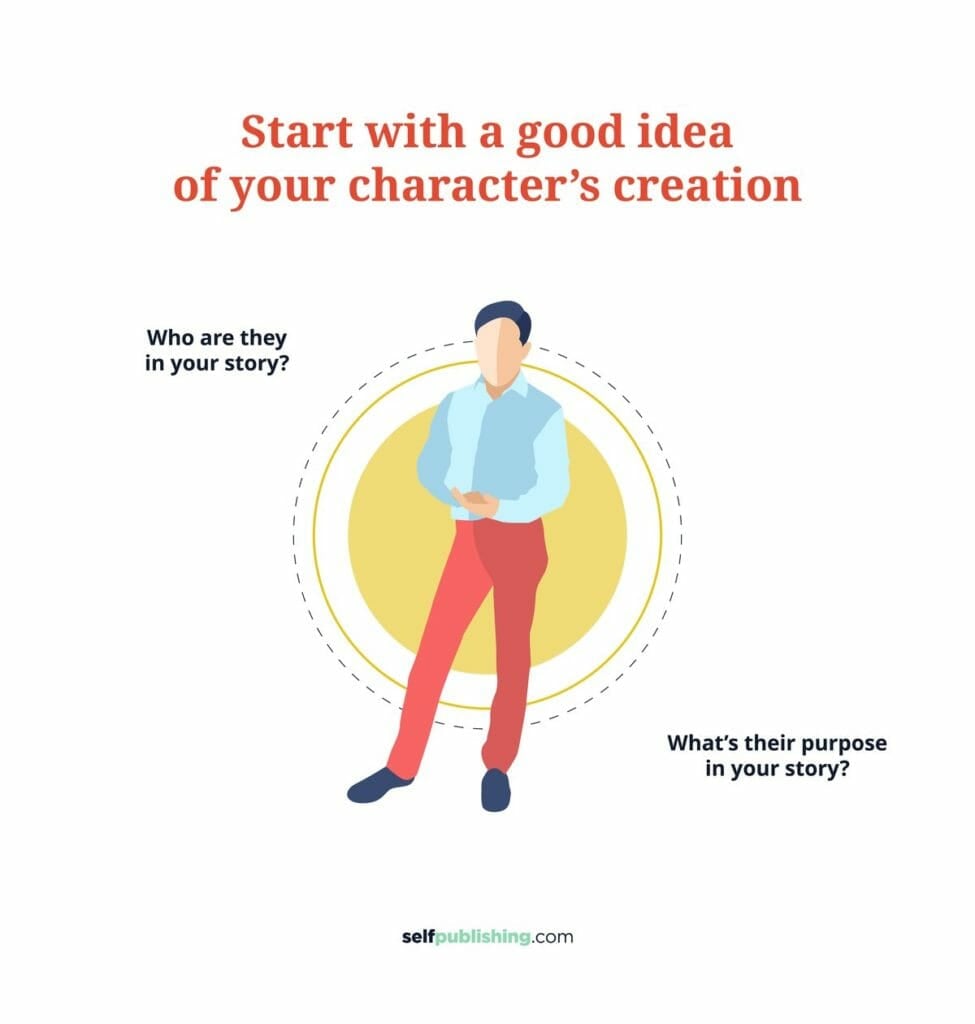
These are the basic questions for your character bio template:
- What is your character's name?:
- Do they have any nicknames?:
- What is the meaning/significance of their name?:
- What is the character's gender?:
- How old are they?:
- When is their birthday?:
- Do they have a death day?:
- What is their zodiac sign?:
- Where do they live?:
- Where were they born?:
- What is their ethnicity?:
- What is their nationality?:
- What is their race/species?:
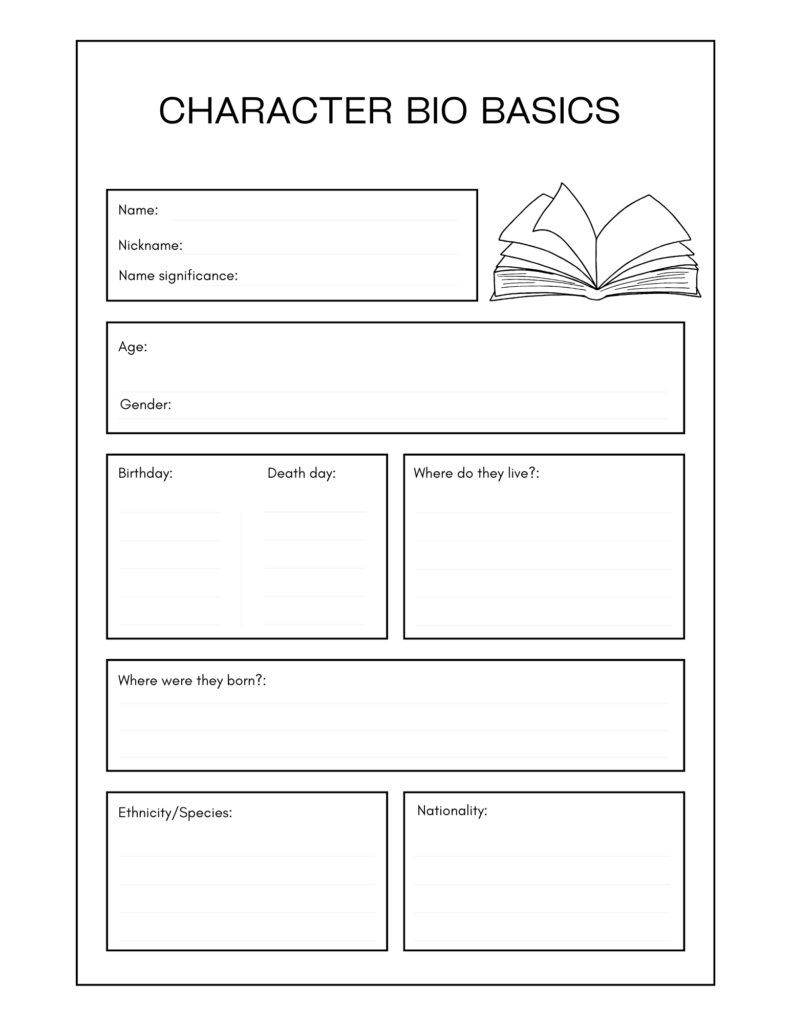
Physical descriptors
Now you can start building out your character’s physical appearance. These are external questions that will paint a physical description, so your reader can envision what your character looks like.
The physical attributes for your character bio template are important because they will also help you write vivid descriptions and actions in your book.
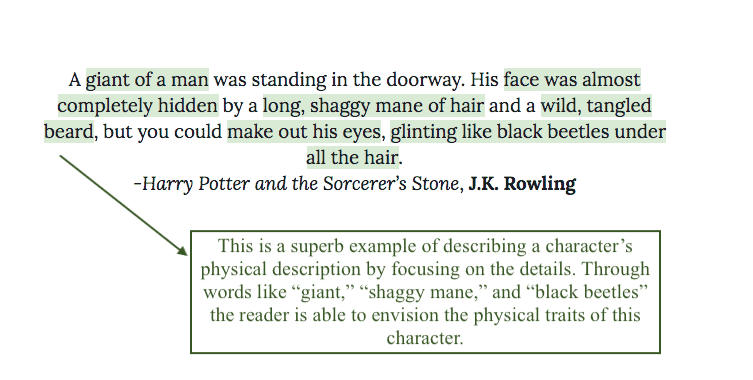
These are the physical appearance questions for the character bio template:
14. What is their physical appearance?:
15. What is their skin tone?:
16. What is their complexion?:
17. What is their natural hair color?:
18. What is their height?:
19. What is their weight?:
20. What is their body type?:
21. What is their build?:
22. How is your character's posture?:
23. Do they have any birthmarks?: 24. Do they have any scars?:
25. Which is their dominant hand?:
26. What age does the character appear to others?:
27. Do they have a dyed hair color?:
28. What is their usual hairstyle?:
29. Do they have any tattoos? What is the meaning behind them?:
30. Do they have any piercings?
31. What is their makeup style (if any)?:
32. What is their clothing style?:
33. What is their clothing size?:
34. What is their shoe style?:
35. What is their shoe size?:
36. How is the appearance of their nails?:
37. How are their eyebrows shaped?:
38. What do their facial features look like?:
39. What is the character's face shape?:
40. Do they have facial hair?:
41. What does their voice sound like?:
42. What distinguishing feature about them do people notice right away?:
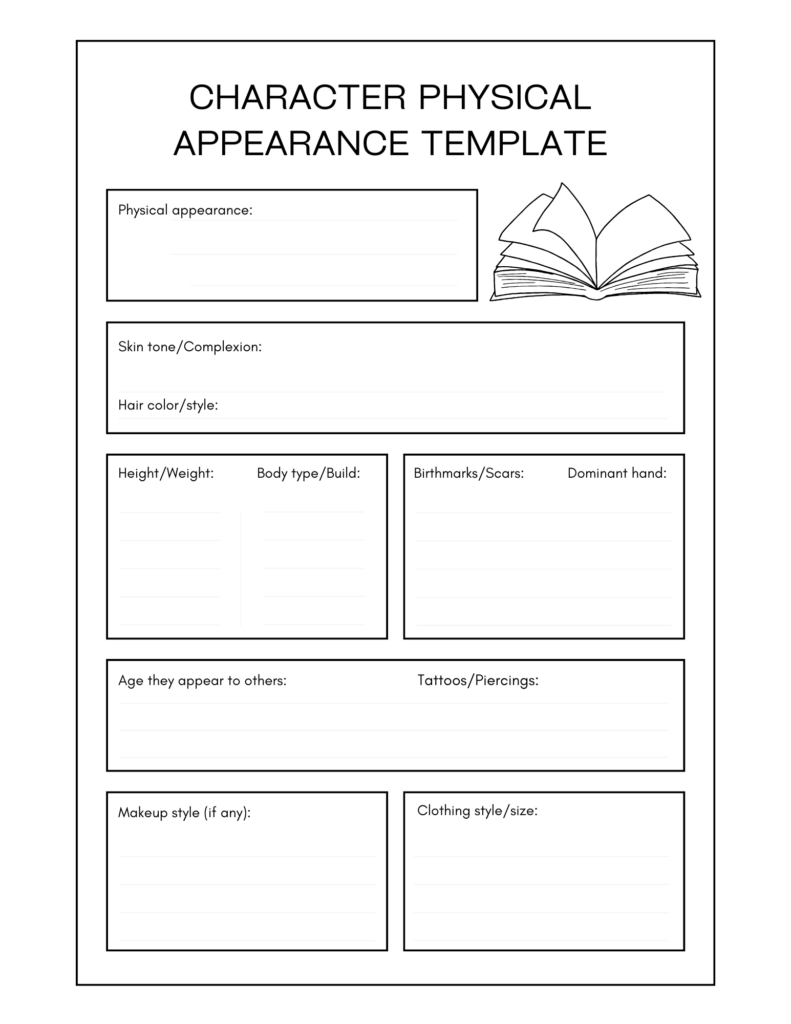
The character's personality
Now it’s time to start scratching beneath the surface to better understand the type of personality the character has. These character development questions focus on describing the personality traits within the character’s demeanor as they are in the present time of the story.
For example, most people who are naturally introverts will always be introverts. But, maybe your introverted character has only recently developed a habit of talking to people on the subway as they commute to work every day.
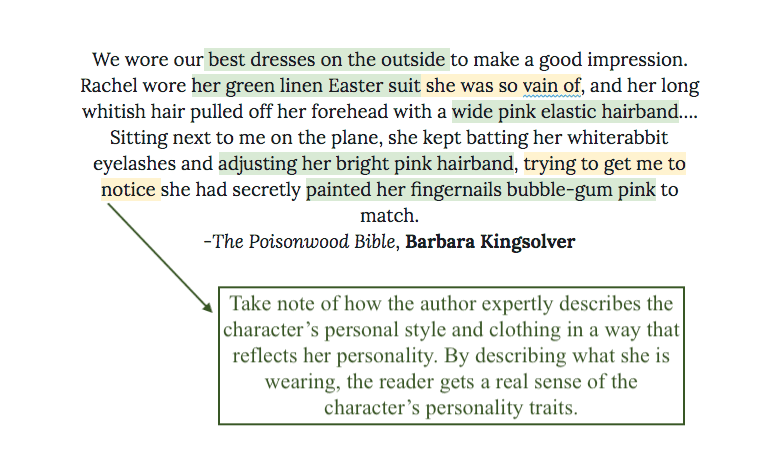
These are the personality questions for the character's development:
43. Are they an introvert or extrovert?:
44. What are their personality traits?:
45. What is their MBTI personality type ?:
46. Are they an optimist or pessimist?:
47. How is their temperament? Are they generally hot-headed, or cool as a cucumber?:
48. What mood are they often in?:
49. What everyday attitude does your character have?:
50. What are their strengths?:
51. What are their flaws?:
52: What are their mannerisms?:
53. What are their habits?:
54. Are they an early bird or a night owl?:
55. Do they have any pet peeves?:
56. Which of the 7 deadly sins does the character most represent?
57. Which virtue does the character possess most?:
58. What are the character's weaknesses?:
59. What are their strengths?:
60. Are they expressive? How do they express themselves?:
61. Are they ruled by heart or mind?:
62. What is their mindset?:
63. What is their philosophy?:
64. What are they motivated by?:
65. What words or phrases does the character often say?:
66. What is their life motto?:
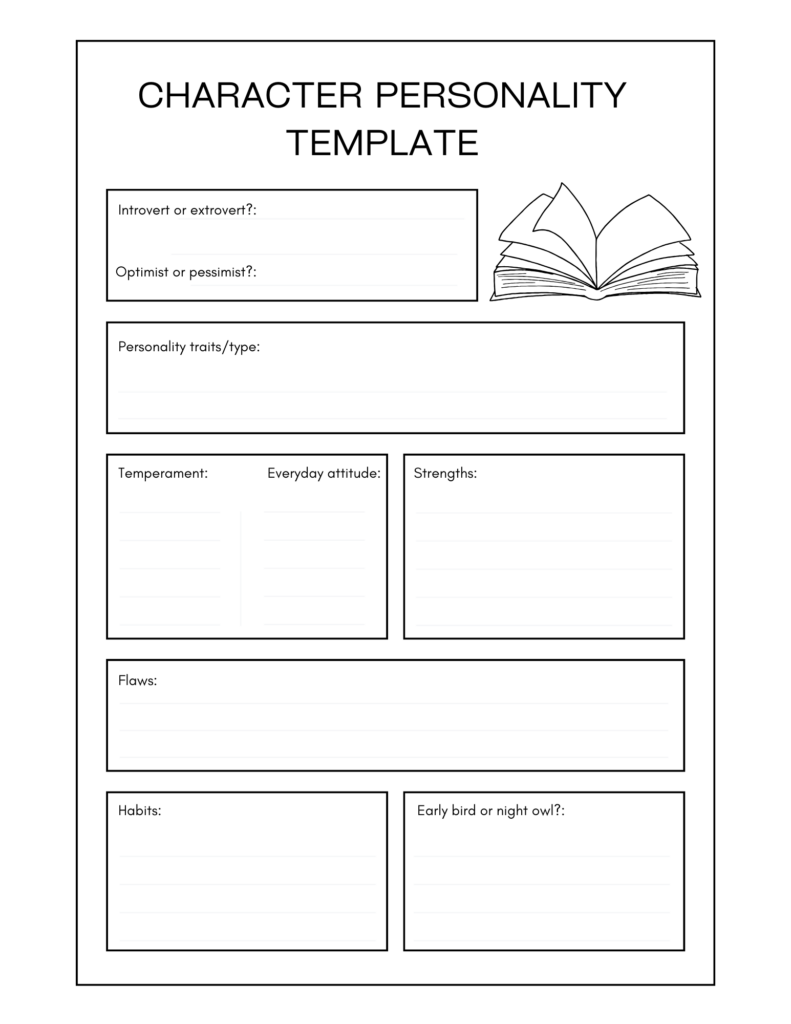
Character health bio
This section is all about your character’s health. It covers everything from mental and physical health, to major surgeries, to allergies.
If certain questions don’t pertain to your character, feel free to skip them. Or, if anything needs to be added, do so. Make this section as relevant to your character as it needs to be.
These are the health questions for the character bio template:
67. Is your character more active, or sluggish generally?:
68. Does your character often forget people’s names, or do they have a photographic memory?:
69. Is your character impaired in any way?:
70. What is your character scared of?:
71. Does your character have any addictions?:
72. Are they fast learners? Do they have poor problem-solving skills?
73. Is your character mentally tough ? What are their mental strengths?:
74. In what aspects is your character mentally weak ?:
75. What are their physical strengths?:
76. What are their physical weaknesses?:
77. Do they have any major past illnesses?:
78. Have they had any surgeries?:
79. Have they been in any accidents?:
80. Is your character emotionally stable?:
81. Do they have any allergies?:
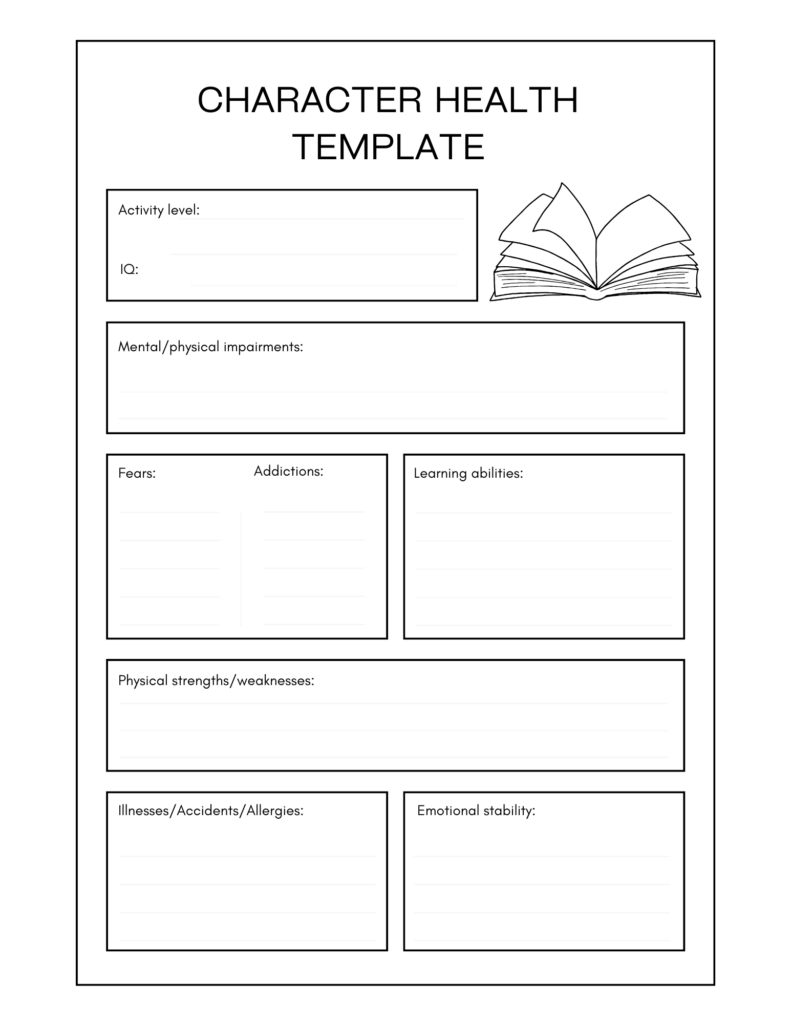
Career details
Now it’s time to cover what your character does for a living – or how they spend the majority of their time. Is your character making a living doing a job they hate, but attending night school to get their dream job?
A person’s choice of career, or their type of dream job, says a lot about that person’s qualities and interests, or lack thereof. That's why it's important to add career questions to your character bio template.
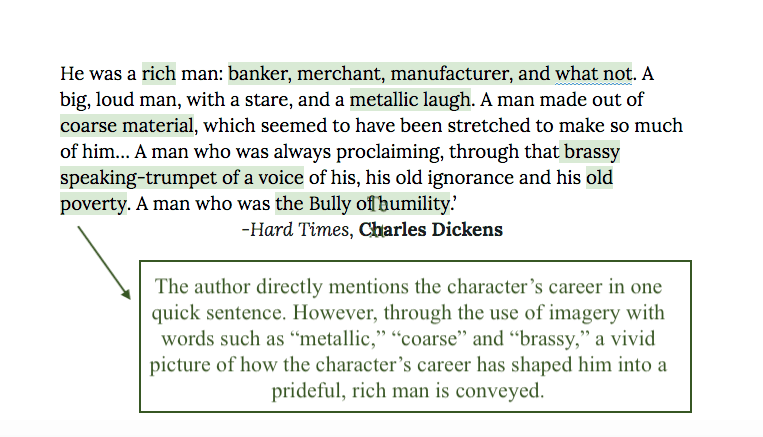
These are the career questions for the character bio template:
82. What is their job title?:
83. What company do they work at?:
84. What type of career do they have?:
85. What is their education level?:
86. Did they go to college? Where? For what?:
87. How is their work ethic?:
88. What is their job history?:
89. What is their income?:
90. What political party/organizations do they belong to?:
91. Do they do any volunteer work?:
92. What is their dream job?:
93. What job would they do poorly?:
94. How is their job satisfaction?:
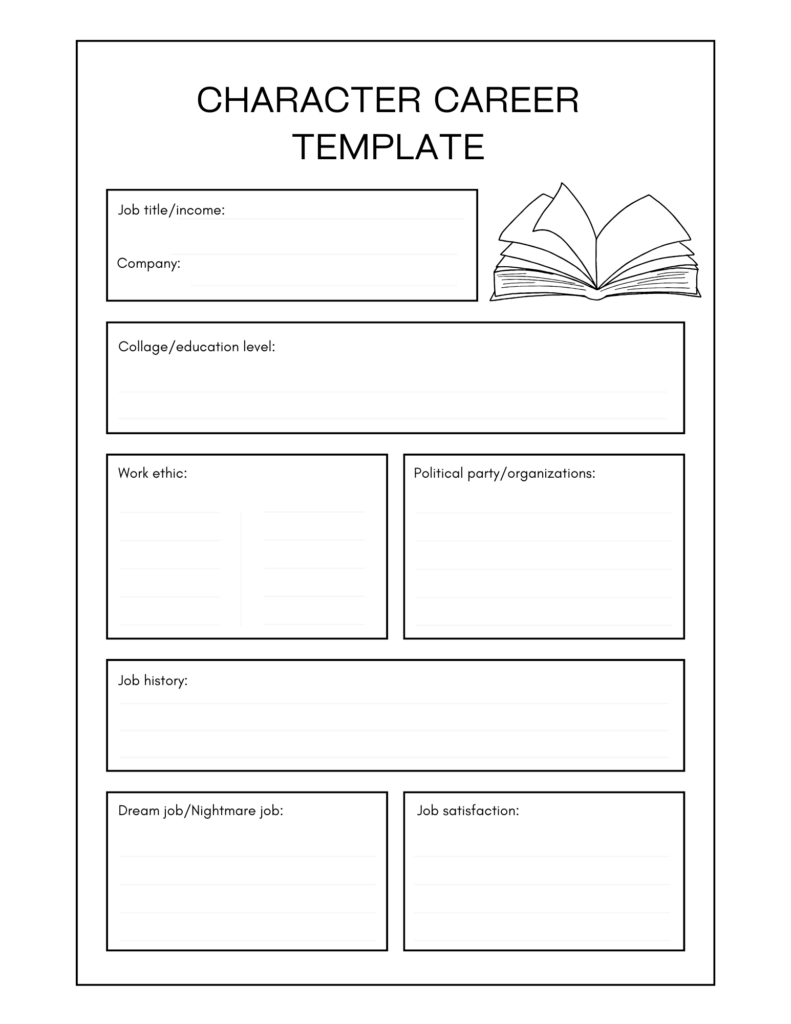
Character preferences
Everyone has their likes and dislikes, from books to activities to the time of day. By answering all of these questions about your character in your character bio template, you’ll be able to build up a person that’s realistic and believable.
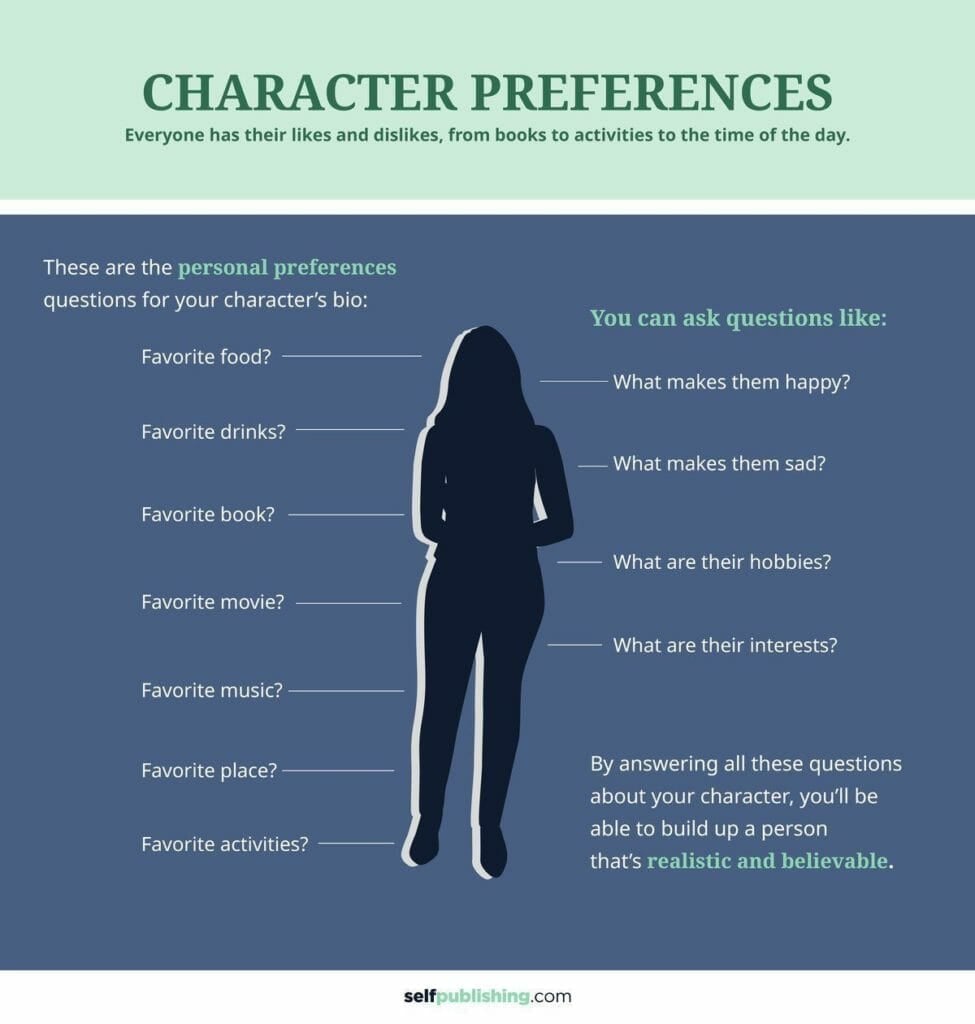
These are the personal preference questions for your character bio template:
95. What is your character's diet like?:
96. What are their favorite foods?:
97. Favorite drinks?:
98. Favorite movies?:
99. Favorite music?:
100. Favorite books?:
101. Favorite animal?:
102. Favorite place?:
103. Favorite activities?:
104. Favorite time of day?:
105. What makes them happy?:
106. What makes them sad?:
107. What are their hobbies?:
108. What are their interests?:
109. What do they love to do?:
110. What do they hate to do?:
111. What are they inspired by?:
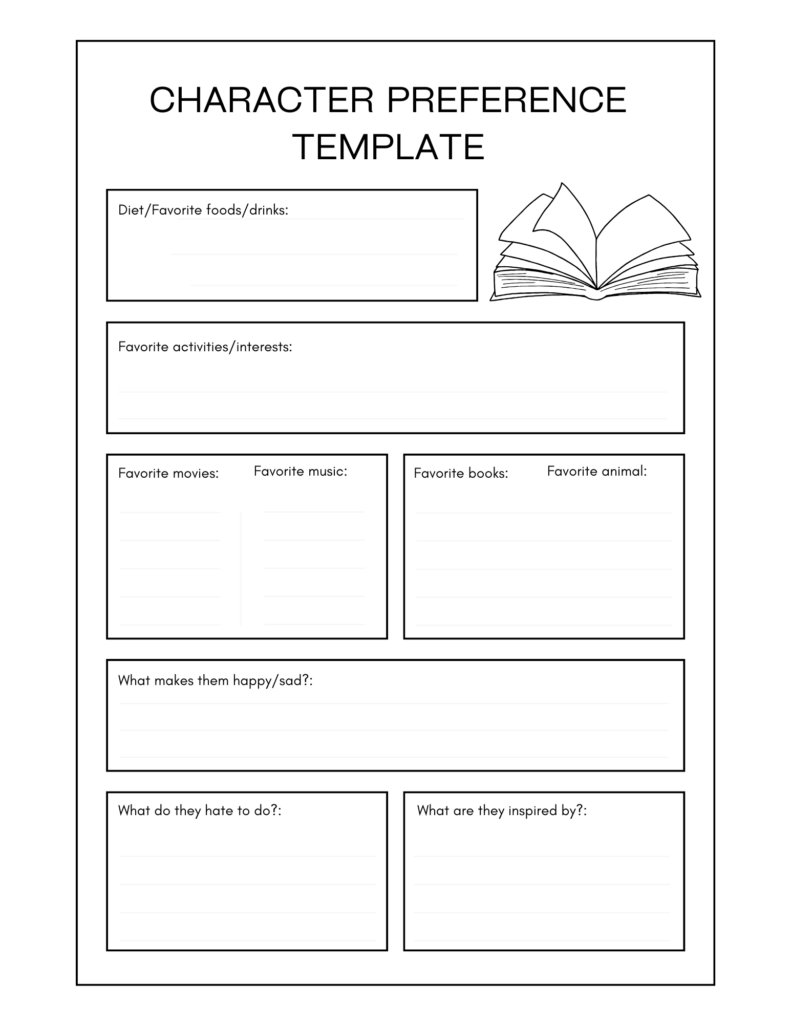
Family life of the character
Let’s face it – family, or a lack thereof, shapes a person. The same is true about your character.
This section is all about your character’s family life, from their parents to extended family, and even pets.
By knowing the family your character came from, you’ll also learn a lot about your character and why they are the way they are.
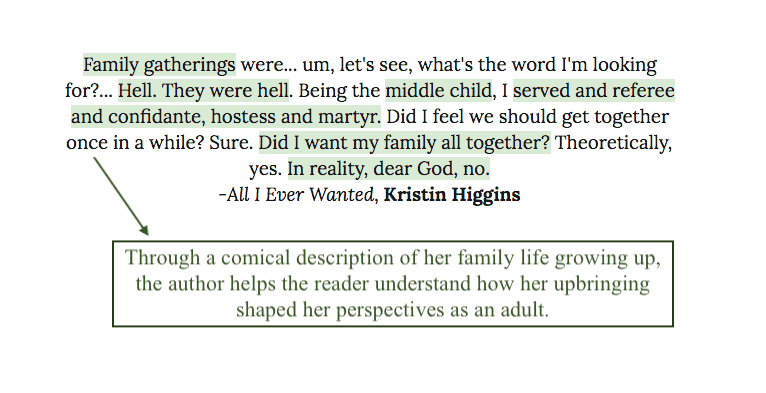
These are the family life questions for the character bio template:
112. Who were they raised by?:
113. What is the status of their parents?:
114. What is their mother's name?:
115. Mother's age?:
116. Mother's background?:
117. What is their father's name?:
118. Father's age?:
119. Father's background?:
120. How is their relationship with their mother?:
121. How is their relationship with their father?:
122. What is their parenting type?:
123. Are they an only child? First, middle, or youngest?:
124. How many siblings do they have?:
125. What is their relationship with their siblings?:
126. Do they have kids of their own, or do they want them in the future?
127. What are some interesting details about their other relatives?:
128. Is their family close-knit or distant? How has family life shaped the character? Do they have any sibling rivalries, or are they best friends with a particular sibling?:
129. What do they like most about their family?:
130. What do they like least about their family?:
131. What are their children like (if applicable)?:
132. Do they have any pets?:
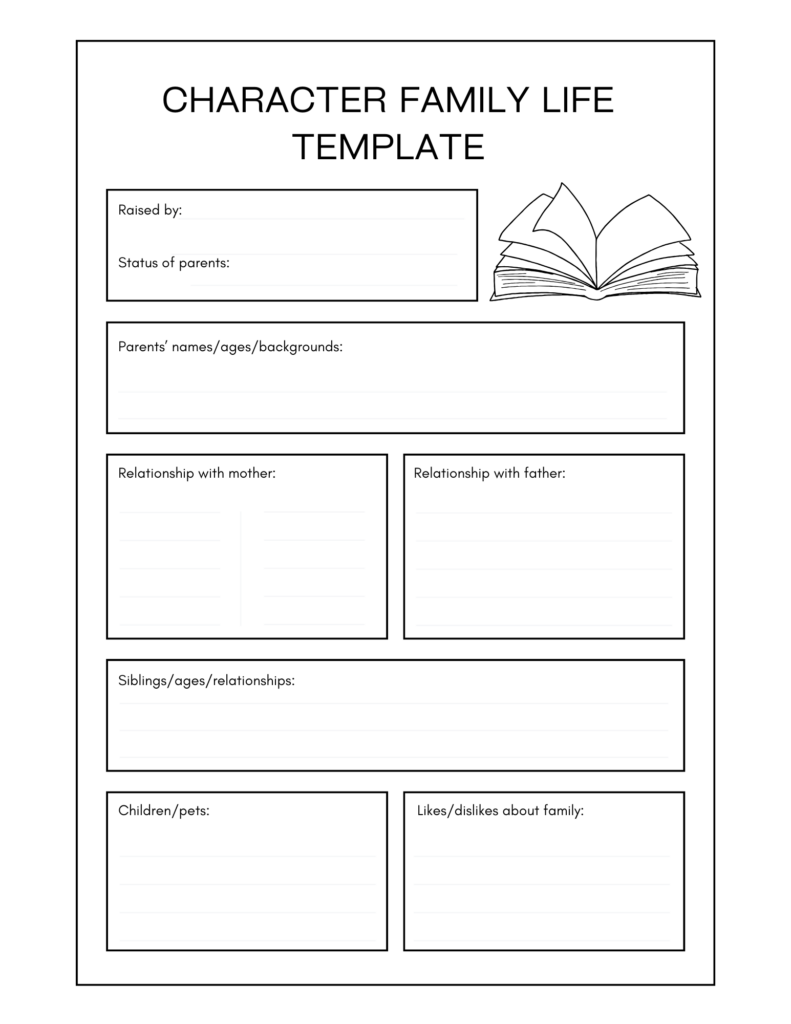
Character bio relationships
In this section, you’ll be answering all the questions that have to do with your character’s relationships – from friends to lovers to enemies.
Think about all of the influential relationships your character has been involved with. Each person, and each relationship, is different, so keep that in mind as you fill out this section of the character bio template.
Each of us becomes involved with people who teach us lessons, whether these individuals stay in our lives long or not. The same is true for a well-developed character!
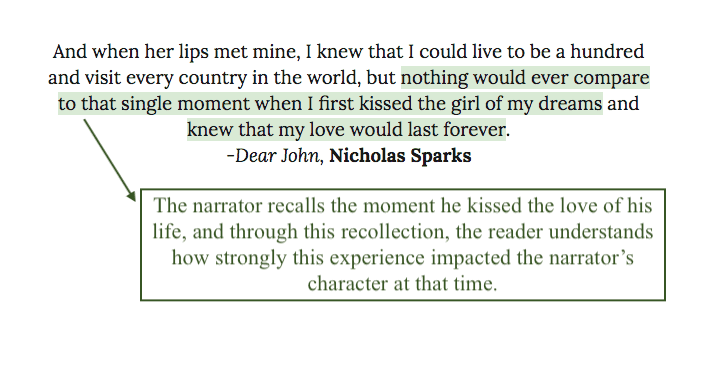
These are the relationship questions for the character bio template:
133. Who are their best friends?:
134. Who is their worst enemy?:
135. Do they have many acquaintances or a few close friends?
136. What is their sexual preference?:
137. Their sexual orientation?:
138. What is their relationship status? Are they happy with it?:
139. Are they married? Divorced? Widowed?:
140. Who was their first love?:
141. Who is their current or aspiring love?:
142. Are there any exes that influenced the character, either positively or negatively?
143. Who does your character love best in terms of their friends and relations?:
144. Who does your character dislike in terms of enemies and acquaintances?
145. Who knows the character best?
146. Who is closest to your character?
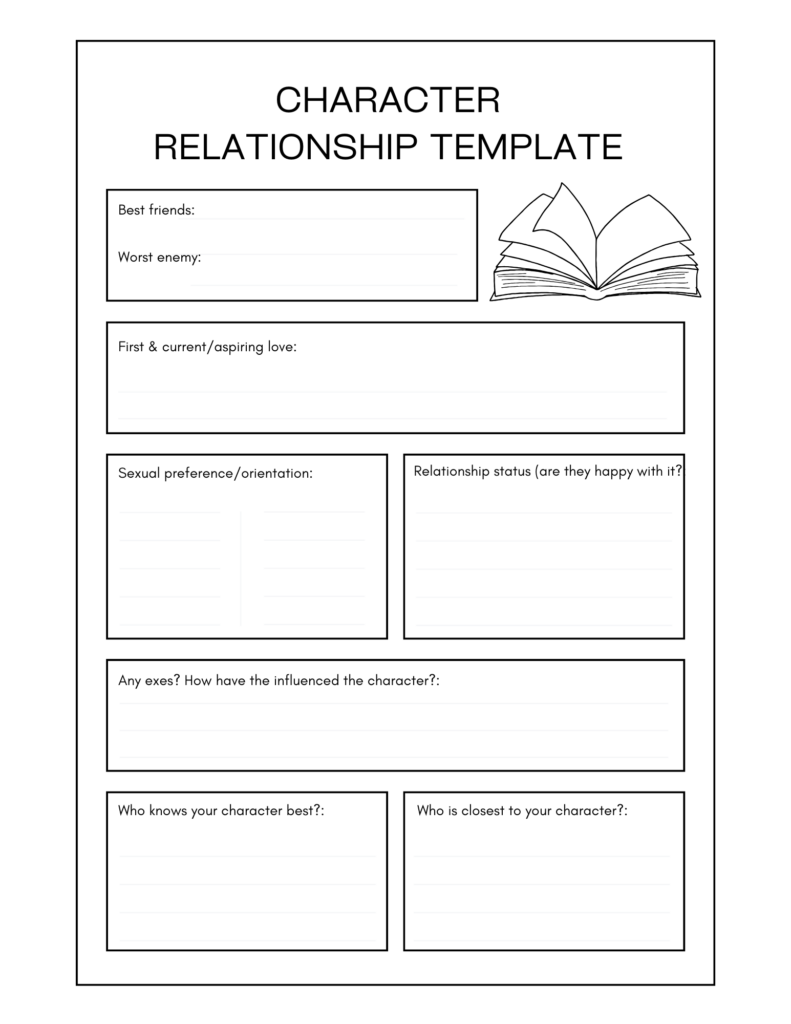
Character template life stages
It’s time to cover your character’s life stages. If your character is an adult in your story, then you’ll want to fill out quick details on each question in this section. If your character hasn’t reached a certain stage yet, just skip that part.
For each life stage, you can write a few sentences to describe the overall time period for the character. Don’t feel the need to list out every single thing that happened to your character in a certain life stage – unless you want to.
These are the life stage questions for your character bio template:
147. What was their childhood generally like?:
148. Did anything significant happen in their childhood?:
149. What were their teenage years like? Did anything significant happen?:
150. What were they like as a young adult? Did anything significant happen?:
151. Have there been any significant events in their adulthood?:
152. When did they really grow up and come into themselves? (Their “coming-of-age moment”):
153. Are there any important moments or experiences that shaped them?:
154. How have they changed as a person throughout their life?: Were they raised as a spoiled only child, but later became a Buddhist monk?:
155. Are there any major regrets the character has from their life?:
156. What are the biggest life lessons your character has learned?:
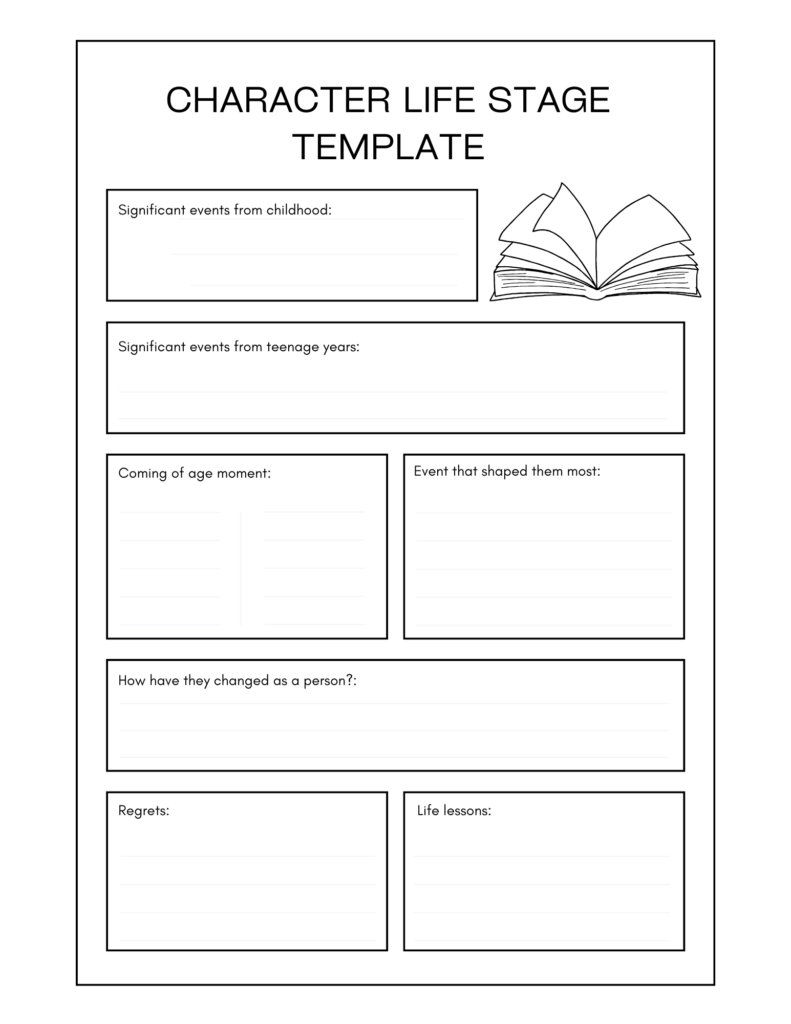
Character perspectives
Next, we’ll go through the questions that will help show us how your character thinks about the world and perceives things.
This is important because it helps shape your character’s mindset, especially if you are narrating the character’s inner thoughts and dialogue.
Filling out this section of the character bio template will also help you as you practice writing in your character's point-of-view, and will give you a sense of your character's thought process, and how their mindset affects their actions.
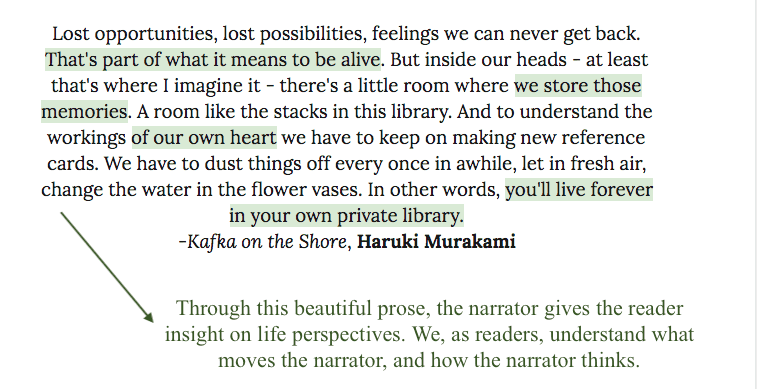
These are the perspective questions for the character bio template:
157. What are your character's religious beliefs?:
158. How was their upbringing?:
159. What are their core values?:
160. How are their morals? What does s/he believe is evil? What does s/he believe is good?:
161. What would your character risk their life for?:
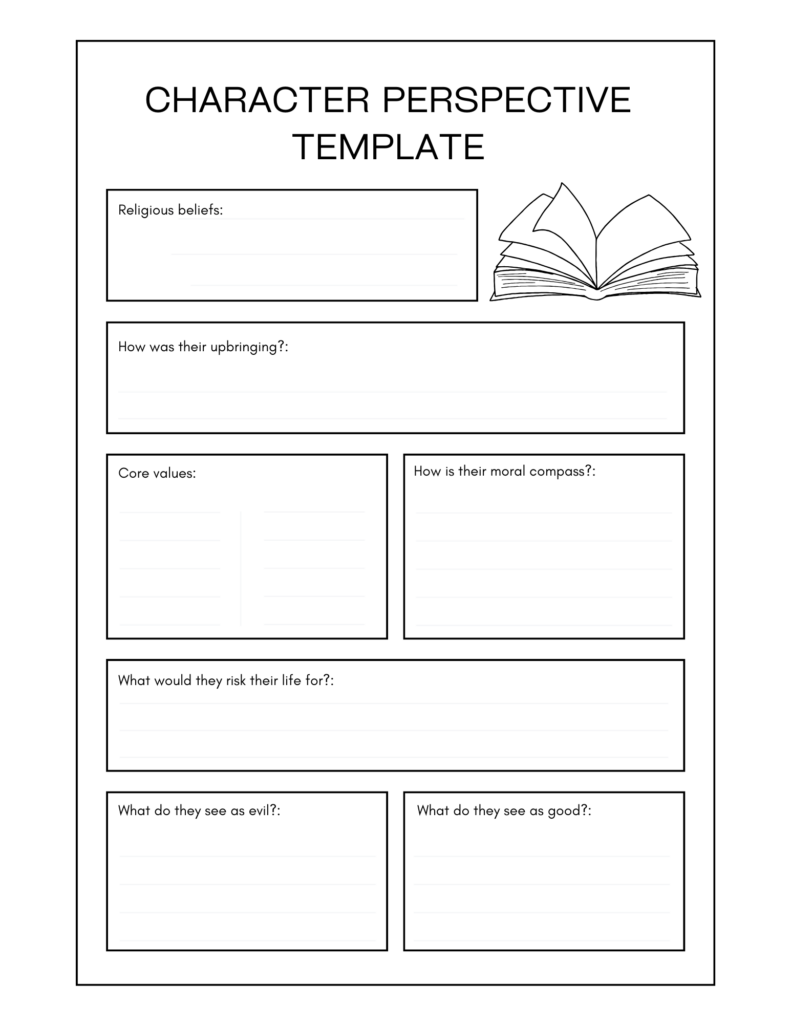
Character's story development
Now it’s time to answer all of the questions that have more to do with your character’s thoughts, actions, and role within your storyline.
You need to know what’s driving your character in the story, and what’s getting in their way. Answer each one of these questions as it relates to your story.
For example, when describing the character’s main goal, don’t answer it in terms of their entire life’s main goal – think of the main goal in terms of your story. Maybe your character’s main goal is to live without regrets. But how does that relate to your story? You need to make it more specific to your plot. Maybe your character’s main goal within the context of your story is to help hide persecuted children, even if it means death and dishonor.
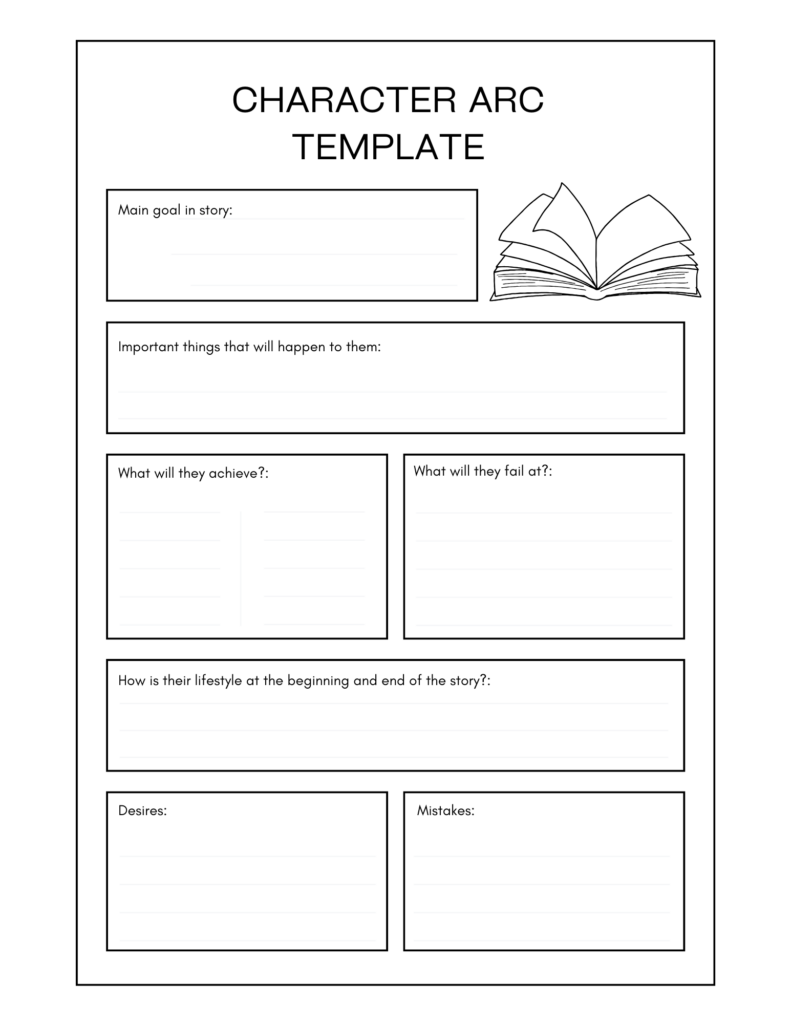
These are the story development questions for your character's development:
162. What important things will happen to the character in your story?:
163. What will they achieve?:
164. What will they fail at?:
165. What is your character’s lifestyle like as it pertains to your story’s time period or setting?:
166. What are some traits your character will possess during your story?:
167. What culture do they identify with?:
168. What is their main goal in the story?:
169. What are some minor goals they have in the story?:
170. What does your character desire?:
171. What are/were their biggest mistakes?:
172. What would “rock bottom look like for your character?:
173. What is their dream life like?:
174. What is their worst nightmare?:
175. What are their favorite memories?:
176. What are their least favorite memories?:
177. What are some things they want in life?:
178. What are some things they don’t want in life?:
179. What obstacles are currently in their way?:
180. Do they have any secrets?:
181. What is their worldview?:
182. Who is their personal hero?:
183. What internal conflicts do they have?:
184. What external conflicts do they have?:
185. What do others think of them?:
186. What do they think of themselves?:
187. What do they wish they could change?:
188. What do they wish they could have?:
189. What gets them fired up?:
190. What do they cherish most?:
191. Things they take for granted?:
192. What inspires them?:
193. What do they have doubts about?:
194. What makes them feel alive?:
195. What makes them want to do better?:
196. What do they want to be remembered for?:
197. How will other people's perceptions of them change?:
198. How will the character change?:
199. What will your character be doing by the end of the book?:
200. How will your character feel at the end of the book?:
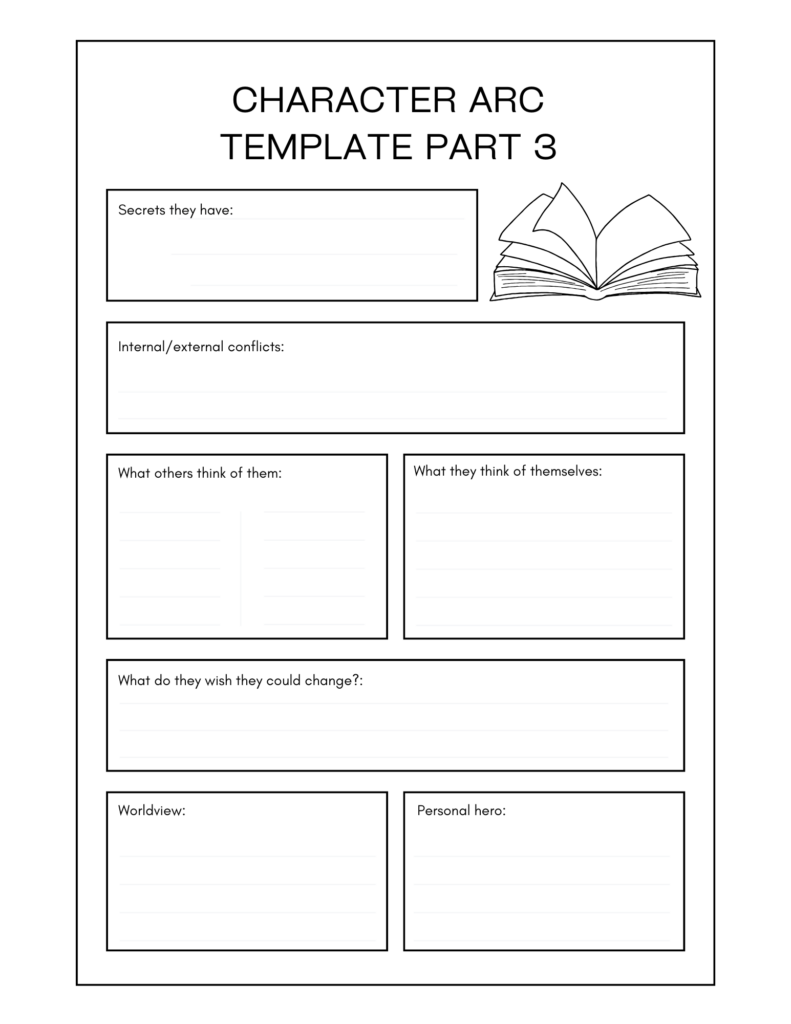
Now that you’ve quickly read through each section of the character template, your brainstorming wheels should be turning as you start to hone in on certain questions about your character that you hadn’t thought of before.
Once you’re ready to start, you can use the blank template below to fill out for each one of your main characters. Remember – keep a copy of your character template sheets nearby for reference as you begin writing!
- Static vs Dynamic Characters
- What Are Stock Characters?
- What Is A Round Character?
Make the most of your character bio template
So there you have it – your very own comprehensive character bio template. Remember, it doesn’t matter what genre you are writing about. Every book should have well-developed characters that come alive through using writing strategies, techniques, and literary elements .

At the heart of every well-written story is a believable character that readers are engaged with and connected to. To create that character, you want to make them as realistic as possible, and you can do that with the help of a character bio template.

Related posts
Self-Help, Writing
How to Overcome Imposter Syndrome: 11 Helpful Tips
What is a mind map: 7 steps to making one and using it to write your book.
Business, Writing
How to Use a Book to Get Leads for Your Business
TRY OUR FREE APP
Write your book in Reedsy Studio. Try the beloved writing app for free today.
Craft your masterpiece in Reedsy Studio
Plan, write, edit, and format your book in our free app made for authors.

Blog • Perfecting your Craft
Last updated on Mar 08, 2024
How to Create the Ultimate Character Profile [+ Template]
Ask any great novelist and they’ll likely tell you that good writing starts with good characters. But sharp character development is also one of the toughest hills to climb, especially if you’ve struggled to think through those tried-and-true questions that keep you up at night:
- Are my characters convincing?
- Do my characters have depth?
- How do I make sure my character has an arc ?
If you’re having these doubts, you might want to turn to the age-old solution: a character profile.
What is a character profile?
A character profile is a detailed biography of a persona that covers everything from their age and appearance to their relationships with others. By understanding parts of their life that readers might not discover during the course of the story, an author can better understand that character’s life, personality, motivations, and their function within a story.
In this post, we will show you our three-part process for assembling a character profile.

What makes a good character profile template?
Many character bibles present exercises that ask you, “If your character was a color, what color would they be?” For many writers, this is either overkill or a bit too 'woo-woo' for their tastes, and they prefer to create a profile that deals in verifiable facts: height, age, and profession.
Our suggestion lies somewhere between those two approaches, where you build a holistic picture of your character in the context of your story. Our character profile worksheet is in three parts. If you treat a person like an apple, they’re going to have three layers of depth: the “skin,” the “flesh,” and the “core.” (Otherwise known as their physical appearance, backstory, and psychology.) That’s how this character profile template is structured — and if you have a particular area that you’d like to hone, you can skip to it below. Otherwise, this character bible will start with the eagle eye’s view of your character.
The Three-Part Character Profile Template:
- The Outer Layer, or Physical Appearance
- The Flesh, or Backstory
- The Core, or Psychology
How to create a character profile
As another reminder, we strongly recommend our character profile template in a PDF format and fill it out as you go along! Download it below for free right here.

FREE RESOURCE
Reedsy’s Character Profile Template
A story is only as strong as its characters. Fill this out to develop yours.
1. Construct the character's outer appearance
To be able to identify a criminal, detectives build a painstakingly thorough file of said criminal’s physical characteristics.
That’s the goal of this section, which covers the “skin” of your character: everything from their outer appearance to the way that they speak. Think of it as a kind of offender profile — one that can help you spot your character in the middle of a crowded Times Square.
The Basics 📖
- Place of birth
- Current location
- Nationality
Physical Appearance 👀
What's their:
Do they have any distinguishing features (tattoos, scars, birthmarks)?
What's their preferred outfit?
Do they wear glasses? 👓
What accessories are ALWAYS associated with them (cane, pipe, necklace, etc.)? 🌂
What's their usual level of grooming?
- Smart, very put together
- Untidy but clean
Do they have any distinguishing “tics” and mannerisms?
What's their health like? Do they suffer from chronic illnesses? 🏥
Describe their handwriting (sloppy, neat, careful, unintelligible). ✍
How do they walk? 👣
- Confident, powerful strides
- Lazy stroll
- Fast, walks at a clip
- Distracted, eyes on the ground

FREE OUTLINING APP
The Reedsy Book Editor
Use the Boards feature to plan, organize, or research anything.
Speech and Communication 💬
How do they talk (rapid, slow, measured, drawl, etc.)?
What's the style of their speech (elevated, educated, peppered with slang, etc.)?
Do they have an accent?
- Stiff, military
- Casual and relaxed
- ‘Turtle,’ tired
Do they gesture?
- Only when agitated or eager
- Doesn’t gesture
- Compulsive “hand-talker”
- Controlled, only to make a point
- Other? If so, explain:
How much eye contact do they like to make (direct, shifty, etc.)?
What's their preferred curse word?
What's their catchphrase?
Any speech impediments?
What are any distinguishing speech “tics”?
What's their laugh like? What do they tend to find funny?
Describe their smile?
How emotive are they? Do they wear their emotions on their sleeve? How easily can others read them?
They have a resting _____ face.
Speaking of great characters... which contemporary author are you ? Take our 1-minute quiz below to find out!
Which contemporary author are you?
Find out which of today's greats is your writerly match. Takes one minute!
2. Build out the character's backstory
Characters don’t exist in a vacuum — they’re a product of their environment.
This section in the character template dives a bit deeper into your character and covers their “flesh”: the people, circumstances, and formative influences that filled them out and made them who they are today. It’s the springboard to your character’s biography.
What's the name of their hometown? 🏡
What type of childhood did they have (sheltered, neglected, etc.)?
Describe their education. 🍏
Were they involved in organizations and clubs at school?
- Gay / Straight Alliance
At graduation, they were named Most Likely To ___________ in the yearbook. 🎓
Jobs (if applicable)? What would their résumé look like? 💼
What was their dream job as a child? Why?
Who were their role models growing up? Describe them. 👨👦
What's their greatest regret?
What were their hobbies growing up? ⛳
Favorite place to be as a child?
What's their earliest memory?
What's their saddest memory?
What's their happiest memory?
What's their clearest memory?
What are their skeletons in the closet? 💀
If they could change one thing from their past, what would it be? Why? ⏳
Describe the major turning points or “life beats” in childhood.
What are three adjectives to describe them as a child?
What advice would they give to their younger self?
List their criminal record. ⚖

NEW REEDSY COURSE
How to Write a Novel
Enroll in our course and become an author in three months.
- Age (if living)
- Briefly describe their relationship with your character
- What are their names and ages?
- Briefly describe their relationship(s) with your character
Children 👶(if applicable)
Extended family 👴
- Grandparents
- Uncles and aunts
What's their family's economic status? 💰
How often do they see their family in a year?
External Relationships 💜
Who are their closest friends? Describe them.
Who are their other significant friends? 👋
Enemies? Describe them. 😡
How are they perceived by:
- strangers in the street?
- acquaintances at a work function?
- colleagues in the office?
- authority figures?
- friends in their friend circles?
- the opposite sex?
- extended family?
What social media platforms are they on?
- X (formerly known as Twitter)
- Other? If so, explain.
How would they use their social media platforms?
How would they fill out an online dating profile for themselves? ✨
What’s their role in a group dynamic? 💡
Who do they depend on for:
- practical advice?
- emotional support?
- moral support?
How quickly do they respond to emails? 📨
What do they want from a relationship?
Who would be their ideal partner? 💖
Who is their significant other? Describe them. 💕
How many people would attend their funeral?
Part 3. Understand the character's goals and motivations
We’ve come now to the “core”: who your character is deep down.
This section in the character profile worksheet covers the “heart” of your character. If a backstory shapes a dynamic character , this will define them. More importantly, it will help inform the two most important points leading up to your novel: the character’s story goal and story motivation .
Psychology 💭
What do they do on rainy days?
- Street-smart or book-smart
- An optimist or pessimist
- Introverted or Extroverted
What is their favorite sound? 🔊
Favorite place in the world? 🌎
What secrets do they keep? What are they most afraid of people finding out? 🔒
What do they want the most? 🔍
What's their biggest flaw?
What's their biggest strength?
What's their biggest fear?
What is their biggest accomplishment? 📈
What is their idea of perfect happiness?
What's their favorite quote? 👌
Do they want to be remembered? What for? ⌚
How do they approach:
What is the one object or possession that they would rescue from their burning home? 🔥
What (or who) bores them? 💤
What makes them angry? 💢
What do they look for in a person?
How strong is their moral compass? When, specifically, are they willing to compromise their morals?
List the last 10 books they read. 📚
Which fictional world would they most wish to visit?
If they didn’t have to sleep, what would they do with the extra time?
What are their pet peeves? ⚠
If they won the lottery, what would they do?
Describe the character’s bucket list at the ages of 15, 20, 30, and 40.
List the 10 songs that would occupy their All-Time Most Played playlist on Spotify. 🎵
What is the best compliment that someone ever paid them?
In an elevator, do they push the elevator button more than once? 🚪
What would they want their tombstone to say?
The Present and Future 🔮
What is their story goal? (answer in a single paragraph)
Story motivation (answer in a single paragraph)
In other words: what does your character want in the story? And why do they want it?
Every other answer in the character profile template builds up to this. It's critical information to know because it’ll make up the unshakable foundation — and raison d'être — for your story. Whenever you feel like your story is straying off course, go straight back to your character’s story goal and motivation, and you'll find the beating heart of your book.
24 responses
Rachel Mendell says:
02/06/2018 – 12:23
excellent! so much info - thank you.
↪️ Reedsy replied:
07/06/2018 – 04:37
Our pleasure, Rachel. Glad that it helped!
Diane says:
07/06/2018 – 08:50
Wow! I tried to find such kind of list many times. Thank you so much! Creating character is always difficult for me. I imagine tutoriage character but it was not full. With this list Finally I will finish it.
22/01/2019 – 15:37
Nice I was gonna make one myself but this is great since normally I obsess to the point of procrastination.
Gwendolyn Clark says:
13/05/2019 – 00:09
I was never sent a copy to download
↪️ Martin Cavannagh replied:
13/05/2019 – 08:20
Hi Gwendolyn, could you drop us an email at [email protected] and we'll sort you out with a link :)
Sabrina Douglas says:
08/06/2019 – 16:40
I have not received the PDF yet.
10/06/2019 – 13:48
With Gmail, our emails often can be found in the Promotions folder. if it's not there, send us an email at [email protected] and we'll sort you out :)
Tactical Weasel says:
08/06/2019 – 23:18
I was never sent a copy to download either.
Ibidun says:
02/07/2019 – 01:47
This is a developed list of questions for sure. Thank you!
susannelorraineharford says:
21/08/2019 – 08:01
Thanks! Great help in this articke. X peace, susanne
james bolin says:
22/08/2019 – 21:05
This my be a crazy question, but I am writing a science fiction book, and I already made character profiles for my ow use. But, that being said, would it make sense to also include a section in the book that includes all the main characters profiles. It would serve as a reference in case someone wants to know the characters hair color, birth date, and other details. any advice would help thanks
23/08/2019 – 09:04
It would be a somewhat unusual move — but it's not for me to say if it's wrong. Often, you see books provide family trees and brief histories of the 'world' of the story... but that tends to be so that readers can check up on facts that are highly relevant to relationships and plot of the book. In almost all cases, readers won't really need to know things like hair color or date of birth. So, I'd think hard before putting a character stat sheet in your book.
↪️ Nyla replied:
02/09/2019 – 16:12
I don't see why not! Some books did it (sort of); Wings of Fire, Tailchaser's Song, Warriors... I don't think including one would be a bad move. Definitely not something that would kill your story. Keep in mind that I'm a beginner when it comes to books, so I may not know any better. I'm just saying that in my opinion, I don't think it's a bad move.
Satyajay Mandal says:
25/08/2019 – 04:31
You can tweet me to get more updates on the story I'm directing
02/09/2019 – 16:13
What do you mean by "education"? Like what school they went to?
17/09/2019 – 09:02
Yup. Are they a college grad? What did they study? Did they leave school at 18 and take up an apprenticeship — that sort of thing.
27/09/2019 – 14:03
Will i ever get the document to download!
07/10/2019 – 15:48
Hi Sky, if you're still having trouble downloading the template, could you drop us a message at [email protected]? Thanks! Martin
20/10/2019 – 03:56
I will update you about all the details
Max Sangers says:
23/03/2020 – 20:16
I like it, just pls refrain from bad language :)
26/03/2020 – 04:49
No need to refrain from using bad language, if it is assigned to the villains instead of the heroes/heroines
26/03/2020 – 05:02
No need to refrain from using bad language if it is assigned to the villains instead of the heroes/heroines
28/03/2020 – 05:01
This is @*#$ing AWESOME!!!
Comments are currently closed.
Continue reading
Recommended posts from the Reedsy Blog

What is Tone in Literature? Definition & Examples
We show you, with supporting examples, how tone in literature influences readers' emotions and perceptions of a text.

Writing Cozy Mysteries: 7 Essential Tips & Tropes
We show you how to write a compelling cozy mystery with advice from published authors and supporting examples from literature.

Man vs Nature: The Most Compelling Conflict in Writing
What is man vs nature? Learn all about this timeless conflict with examples of man vs nature in books, television, and film.

The Redemption Arc: Definition, Examples, and Writing Tips
Learn what it takes to redeem a character with these examples and writing tips.

How Many Sentences Are in a Paragraph?
From fiction to nonfiction works, the length of a paragraph varies depending on its purpose. Here's everything you need to know.

Narrative Structure: Definition, Examples, and Writing Tips
What's the difference between story structure and narrative structure? And how do you choose the right narrative structure for you novel?
Join a community of over 1 million authors
Reedsy is more than just a blog. Become a member today to discover how we can help you publish a beautiful book.
The Ultimate Character Profile Template
Unique characters drive compelling stories. Develop yours with our free template.

1 million authors trust the professionals on Reedsy. Come meet them.
Enter your email or get started with a social account:
Character Bio Template – How to Create A Character Bio
August 14, 2023

Creating a new character for your story is magic. You breathe life into a new and exciting character. Apart from that, it is also highly important for writing a coherent and logical story. Hence, you should know your characters (at least) as good as your mother. Pretty hard eh?
No worries, we created a character bio template that includes 73 important questions and attributes you need to answer and define before starting to write your story . The character bio template will help you to make sure that your characters seem real and authentic.
You should fill the character bio template for all your characters. If you recognize that you need to change some attributes of a character, don’t forget to update the template as well. It should really help you to organize your thoughts, to avoid forgetting any important traits or features of a character and to get the full picture of the existing relationships between your characters.
Of course, you can decide about the level of bio detail for each of your characters. But, often, it makes sense to detail them out as much as possible. This will not only give you a better understanding of the potential role of the character in your story but will also help you to describe situations the character is involved in.
Speed up your review rounds for good
Get feedback on videos, designs, websites, and more with Filestage.
What’s a Character Bio?
So, creating a character biography is quite important and will help you to build your story. Of course, you want to start writing. But take this break and start by defining the attributes, features, and characteristics of your characters first. Trust me, it will help you to write a better story.
So, let’s dive into the character bio template.
BTW: We also created a Template that allows you to edit and update your templates easily. The good thing: You can use it for free. If you want to use it, just create a copy of the spreadsheet.
Download a free character bio template
Fill out the form below to get instant access to our character bio template.
To save an editable copy, follow these simple steps:
- Click “File” in the top-left corner
- Click “Make a copy”
- Choose your destination folder
Get the free character bio template
Character bio template, general information.
Full name Nickname: Age: Nationality: Religion: City of birth The current place for living Job title: Employing company: Income: Is he or she married? Mother tongue Birthday: Does he or she own a home? What does the character like? What does the character dislike?
How would you describe the childhood of the character? How would you describe the teenage years of the character? How would you describe the adulthood of the character?
Role and Involvement of Character
What’s the role of the character in the story? How is the character introduced? What’s the first time he is mentioned in the story?
Relationships
Sisters or brothers Wife or husband: Children Grandparents Grandchildren Other important persons: Relationships with other characters of the story: [Character 1] [Character 2] [Character 3] [Character 4] [Character 5]
Physical Characteristics:
Addictions: Bad Habits: Color of Eyes The color of Hair: The color of Skin: Dialect Does the character drink regularly? Does the character have any disabilities? Does the character prefer any proverbs? Does the character smoke? Good Habits: Height: Hobbies: Is he/she wearing Glasses? Is the character healthy or does he have any diseases? Type of Face: Weight: What’s the style of the character? (modern, outmoded):
Mental Characteristics
Education: Intelligent or not? Fears: Life Goals (next 5 years): Life Goals (next 25 years): Self-perception Assumed external perception Self-Confidence: Rational Or Emotional How could you upset this character?
Emotional Characteristics
What are emotional strengths of the character? What are emotional weaknesses of the character? Is the character an introvert or an extrovert? How does the character cope with fury and rage? … with unhappiness? … with rivalry? … with new situations? … with trouble? What’s his or her meaning of life? What would the character like to change in his/her life? What things motivate the character? What situations scares the character? What makes this character happy? Is the character often biased? Does the character prefer to give or to take? Is the character rather nice or rude?
I hope you liked this character bio template. If you have important additional questions, attributes or characteristics that are missing on my list, feel free to leave comment. I would love to add them to the list.
If you’re having trouble getting started on flushing out your character, you can also try using new AI tools like ChatGPT or HubSpot’s content writer to build a rough outline of your character to get started.
Get marketing tips, trends, and inspiration in your inbox
Everything you need to create your best work, delivered from our brains to yours every other Wednesday.
Improve your writing in one of the largest and most successful writing groups online
Join our writing group!
Character Bio Template for Creating the Perfect Characters

by Holly Riddle
The best books offer characters that feel like real people, characters that are so fleshed out and thorough that you feel as if you really know them. But creating those types of characters is easier said than done!
Once you sit down to start drafting a new short story or novel, you may find that your characters are feeling lackluster at best, or entirely dull at worst. How can you fix this? No matter what stage of the writing process you may be in, creating a character biography using a character bio template can be a great help.
What is a character biography?
A character biography is a reference sheet that tells you everything you might need to know about your character, for any scene that you write. A character bio includes information on your character’s background, personality, day-to-day life, appearance, and more. While not all this information will make it into your story, it’s still useful for plotting your character’s arcs.
Why is having a character biography important?
If you consider yourself more of a pantser than a plotter (i.e., the type of writer who goes into drafting flying by the seat of their pants versus the type of writer who plots and outlines their work ahead of time), then you may wonder if you really need a character biography—especially when you look at character bio templates that ask you for far more information than you might think you need (do you really need to know your main character’s childhood pet’s nickname?).

However, no matter your drafting style, a character biography can be an invaluable resource. The more information you have at the ready, the more well-rounded your characters will be. You might even find that having a character bio template as you write will help you unravel other writing issues that go beyond flat characters, like plot holes or character or story arcs that don’t quite arc .
Things to keep in mind before you write your character biography
Before you write your character biography (using our handy template below), there’s one big thing you need to think about: each character’s purpose within the story .
Often, writers will begin building a character first, thinking about things like personality and appearance and motives—and then wait until they’ve developed this character before actually giving the character a purpose within the story.
This can be problematic for a few reasons, but primarily because you may end up trying to force characters into roles where they don’t belong.
Before creating any character bio or filling out any character template, consider why you need this character in the first place. How are they going to pull their weight?
Think beyond the very baseline role that they might play, as, for example, a main character, love interest, antagonist, or the comedic relief. Think about what they need to be and what they need to offer the plot and your other characters. What makes them so essential to the plot that they absolutely cannot be cut from the story or book?
Once you nail down why this particular character must exist in your fictional universe and exactly what they offer the plot and main character that makes it so, you can begin filling in the more extraneous details that might not matter quite as much, such as basic info and appearance. On the contrary, once you decide on your character’s purpose, you may just find that those details aren’t so extraneous and are, in fact, all the more meaningful.
How to write a character bio (using a template)
When you download your character bio template and begin filling it out, whether you print it and write out all the details by hand or type everything into the Word doc, you’ll notice there are a few details that you need to include.
This is likely all information that you have stored away in your brain somewhere, so getting it down on the page should be no problem.

Think all the information that anyone might be able to find out about your character if they either knew them as a brief acquaintance or looked them up online and discovered a social media profile.
This might include things like:
Nationality
Religious beliefs
Home town and current place of residence
Marital status
Economic status
Core values
If there are any stand-out likes or dislikes, or pet peeves, you can also list those here. For example, does your character prefer to only communicate via snail mail, or does your character dislike chocolate with a passion? List it here!
Appearance and physical characteristics
Think not just of your character’s physical appearance, body type, and personal style, but also how their appearance impacts how they act and how they’re treated.

Do others approach them differently than they might another character, all because of appearance? Does your character like their appearance? Why or why not? How does this impact how they interact with others?
For many characters, health—or the lack thereof—plays a major role in their decision-making and motives. Think about your character’s health and the areas where they might be struggling.
Does your character drink regularly or have any addictions? Bad habits? Does your character smoke? Were they in any sort of traumatic accidents that have made their health a challenge?
Think about your character’s life up until the point were your story begins. What was it like?
Did they have a good or bad childhood? How were their teenage years? Are there any major changes between the way they grew up and the way they live now (i.e., changes in religion, place of residence, best friends, or social or economic status)? How does that influence their behavior and beliefs now?
In real life, background heavily influences the way a person acts and the choices they make, so the same should apply to your characters.
Relationships
What is your character’s relationship with the other people within the story? How do they feel about the other characters? This includes romantic relationships but also those with friends, family, and work colleagues.
Explore how these relationships and all the emotions that go with them impact how your character behaves.

Personality, mental characteristics, and emotional characteristics
What is your character’s personality? Are they shy? Hot-headed? Temperamental? Stubborn? Does your character prefer being around people just like them, or do they love variety?
When building your character profile, think of both your character’s emotional strengths, as well as your character’s emotional flaws.
Your character’s personality will directly play into their thorn, which leads us to…
Character thorns
A character thorn is something that’s stuck in your character’s side. It’s always there, paining them, nagging at them, making their life a little bit worse.

This thorn will eventually propel them to some sort of action and they’ll eventually learn to either live with, or remove, their thorn, but it needs to be there at the start of their fictional journey.
A character thorn could be a bad relationship with parents, a spouse that always outshines them, or a belief that they’ll never be quite good enough. Whatever it is, though, it’s something they can’t ignore.
Every character needs a desire. What do they want? Or, better yet, what do they want so badly that they’re going to end up going after it over the course of your story or novel?
This desire should make sense according to the other information that you’ve already inputted into your character bio template, such as background, thorn, personality, etc.
For example, a character who grew up in an impoverished household with an emotionally neglectful parent, who doted on their other siblings first and foremost, might desire a high-paying career that will allow them to outshine their sibling while also buying their impoverished parents a new house, thus winning their favor and proving themself better than the sibling.
Character development
Your character’s desire and thorn should play into your character’s arc and development. How will they change over the course of your story?
Consider writing up a brief description about your character’s existence at the start of the story—what their life looks like, both externally and internally—and then another brief description about where you’d like them to end up at the end of the story.
Mistakes to avoid when building character bios
As you consider the above details, make sure you avoid some of the most common mistakes that writers are likely to commit when building out, and then using, a character profile.

Using every single detail in a character bio template
This is the big one.
Yes, you’ll have a lot of valuable information in your character bio template. However, you don’t want to merely dump all of that information into your story as soon as you introduce a new character.
The reader doesn’t need—or want—to know all that information at once. They want to gradually learn that information as they get to know your character, over the course of the story.
Don’t dump everything about your characters’ appearances onto the page at once, either. Doing so can make a passage feel stilted and awkward.
After all, when you meet a person for the first time, you don’t automatically think about every color they’re wearing, every brand of clothing they have on, their hair color, eye color, weight, and face shape, all at once. Instead, you maybe notice a few stand-out features until something gives you reason to notice another detail of their appearance.
Do the same when you begin writing a character’s physical description.
Adding details that don’t make sense
Every part of your character’s life should make sense. Their personality, their decisions, their lifestyle—it’s all a result of things that have happened throughout their life.
Don’t pick personality traits or background information at random. With every character detail, ask yourself, why? Truly think about why your character is the way that they are, and ensure every detail is believable.
Does every character need a character bio?
You’ll find that many characters within your story don’t need a full character bio. Minor characters that only play a small role within your story don’t need to be fleshed out to this degree.
However, it’s advisable to create character bios for all of your main characters, and also your secondary characters , including love interests, villains and other characters whose actions heavily influence your main character and/or the plot of the story.
Remember—every character in a story, no matter how large or small their role, has a background, motives and goals. Sometimes, knowing all this and more can help you make the writing decisions that result in believable characters and plot lines.

The Scribophile character bio template
Need more help?
Download our character bio template for an easy, fill-in-the-blanks approach to character template building.
You’ll still need to thoroughly consider every aspect of your characters’ personalities, lives, backgrounds, motives, and more, but, with our character bio template and comprehensive list of questions, you’ll be that much closer to uncovering all the need-to-know details to bring your characters to life.
Download the Character Bio Template (docx)
Download the Character Bio Template (pdf)
Get feedback on your writing today!
Scribophile is a community of hundreds of thousands of writers from all over the world. Meet beta readers, get feedback on your writing, and become a better writer!
Join now for free

Related articles

What is a Protagonist? Definition, Examples, and Tools

What is a Flat Character? And When To Use Them In Your Writing

What Is an Antihero in Literature? Definition with Examples

What is “Fridging” in Fiction Writing?

What is a Foil Character in Literature? Definition & Examples

What is the Mother Archetype? With Examples

Character Bio Templates: How To Write & Examples
Whether crafting fiction stories or developing character studies for performance work like theater, detailed character bios bring your protagonists to life by capturing rich backstories, motivations, personalities and defining moments launching their on-page journeys. Compelling character biographies set the stage for fully formed figures audiences relate to.
This guide explores tips for developing multidimensional character bios along with template examples to model helpful starting approaches capturing both critical plot details and resonating personality essences in your own casts. Let’s start by reviewing key elements to include when profiling characters.
Elements to Include in Character Bios
Impactful character biographies encompass:
Backstory Facts
Overview context like date and location of birth, family members and pivotal settings establishing identity and explaining inherent perspectives tied to upbringing. These building blocks lend realism grounding decisions. Share only most relevant lifestage moments contributing to current outlooks.
For example: Grew up as shy middle child on remote 1960s Midwest farm inspiring solitary hobbies like birdwatching and reading.
Vital Statistics
Capture defining physical traits and biographical data helping envision characters through memorable filters establishing cohesive first impressions around age bracket, appearance and more subtleties like speech patterns.
For example: 32 years old, wiry red hair with slight limp from early injury making self-conscious in crowds.
Personality Profile
Showcase 1-3 standout character attributes through demonstrative examples that make your protagonist compelling, quirky or praiseworthy. These memorable personality hooks attract reader investment through relatability, likability or intrigue.
For example: Brutal honesty regardless of social cues frequently gets her trouble yet she can’t resist exposing hypocrisy. Vlad has signature booming laugh immediately distinguishing his presence.
Motivations & Goals
Explore innermost values and ambitions driving your character’s journey. Are they seeking redemption for past wrongdoings or trying attaining career success to support family? Detail complex psychology through emotional wounds, pressing needs and hopes adding depth.
For example: Seeks trailblazing scientific discovery before disease progresses rendering him bedridden like ancestor inventors. Vies being first female taekwondo champion proving petite athletes mighty.
Let’s examine some example character bio templates putting these key dimensions into action across common creative settings.
Character Bio Examples & Templates
Here are five sample character bio templates spanning fiction stories, theater script development and role preparation best practices covering different core focal points:
Fiction Story Character Bio Template
Full name: Cassandra “Cassie” Brianne Jacobs
Birthdate & Zodiac: March 19th, Aries
Physical: 5’2” petite frame, shoulder-length brown curls, hazel eyes
The younger of two daughters, Cassie grew up outside Portland enveloped in Pacific Northwest evergreen wilderness inspiring a vibrant imagination and wonder of natural worlds. Childhood haemophilia curtailed wilderness adventures leading to solitary hobbies of writing fantasy stories set hiking misty forests. Witnessing inequality towards her disabled father despite diligent provision for their family instilled an innate impulse challenging injustice through thoughtful rebellion from youth through college women’s rights protests.
Personality profile
* Champion of human rights & environmental protection
* Habitual journaler processing observations into reflective action
* Temperamental debater quick to challenge faulty logic or oppression
* Enthusiastic laughter breaks tension Showcases both strengths and growth areas
Motivations closing paragraph
Today, Cassie feels restless in unfulfilling admin role yet fears pursuing activist writing career won’t make ends meet. She decides embarking solo camping trip along Oregon coast for clarity on how to interweave world betterment with personal purpose beyond conventional checklist chasing cultural validation she inconsistently desires. But fate has unexpected encounters in store...
Theater Character Biographies Template
Character Name & Vitals
Natalia “Nat” Cresswood 36 years old5’5” lean dancer physique, shoulder-length curly black hair often worn pulled back in messy bun, green eyes peering intensely taking everything in
The middle daughter of three to an affluent Boston investment banker and philanthropic mother, Natalia grew up participating in gymnastics and ballet dancing from age 4. While she demonstrated natural physical gifts starring incompetitive dance troupe performances through adolescence, Natalia felt increasingly creatively confined by strict choreography regiments and passive gender social norms encouraged among her elite social circles. At 19 Natalia moved to NYC to pursue commercial dancing career and avant garde performances allowing embracing her feminist, queer identity.
Personality & Quirks
* Signature move involves spinning from floor into powerful stance signifying empowerment
* Communicates through spare, precise language and sustained eye contact
* Habitually observes her surroundings before entering new spaces
* Fidgets hands when frustrated suggestive of restricted inner voice
Goals for This Story
Having sacrificed artistic fulfillment the past 10 years for commercial stability paying bills, Natalia realizes sculpting empowerment stage work fusing dance, music and monologues must take priority now before time passes by. But reconciling lingering internalized social expectations around women’s “proper place” remains Natalia’s hidden conflict throughout her visionary choreographic journey.
Method Acting Character Background Exercise
Character basics
Full name: Jonathan “Johnny” Mikeal Vincent
Age & DOB: 43 - January 18th 1980
Physical: 5’10” muscular builder’s frame, close cropped salt & pepper hair with soul patch, hazel eyes
Origins & Upbringing
Born in working class Boston neighborhood, Johnny grew up youngest of 5 children stretched thin by his father’s meager construction wages. Witnessing his overwhelmed parents’ arguments over tight budgets and bringing up 5 kids persevering through scarce means imprinted practical resourcefulness and protective loyalty towards family from young age. Streetfights defending younger siblings also molded reflexive physicality meeting perceived threats with force versus diplomacy - qualities that both served and hindered future dealings rising ranks of local crews.
Personality Qualities
* Brash boldness asserting needs without hesitation
* Observant assessing surroundings before acting
* Generous providing for inner circle no questions spared
* Temper simmers erupting if boundaries crossed
Present Day Motives
Now a rising lieutenant managing illegal arms trade bypassing moral discomfort by rationalizing providing for family above all. Yet Johnny’s protective loyalty gets tested through unforeseen medical crisis forcing reflection on how far he’ll go for kin, crew and his own legacy.
Mix and match components from these templates to build rich multidimensional character biographies fueling vibrant personalities advancing your creative storylines or performances.
Tips for Crafting Standout Character Bios
Beyond covering the core factual and personality elements in your character profiles, apply these additional writing best practices:
1. Uncover defining Epiphany Moments - Explore when your character’s worldview or approach shifted through pivotal interactions altering their place (e.g. first heartbreak, missed promotion, act of betrayal) then map effects on current perspective.
2. Ask probing Questions - What does your character dread most? Dream of late at night? These emotional drivers shape reactions.
3. Contrast Public vs Private Selves - We all portray polished public personas hiding trickier private truths. Expose both along with what formed each.
4. Leave Mysteries - Avoid overdetailing every past moment that defined them. Allow pockets of ambiguity leaving gaps to fill in later keeping intrigue high.
With robust profiles assembled for your leads, supporting roles and antagonists, let’s go over some FAQs on applying character bios improving creative development across different mediums:
Character Bio FAQs
Here are answers to common questions around leveraging rich character biographies to enhance storytelling potency:
Do novels require character bios?
While not mandatory, crafting detailed character profiles outlining backstories, motivations, personalities and pivotal moments often allows authors tighter continuity referencing these key origin details subtly dropping them through dialogue, narration foreshadowing and dramatic irony. Keep bios handy avoiding uneven character shifts.
How do actors use character biographies?
Performers heavily reference developed character bios and backstories to assume roles more immersively through informed emotional connection versus surface reciting of lines. Bios prompt harnessing personas psychologically manifesting authentic expressions, reactions, mannerisms aligned to complex figures crafted through writing phases.
Can you reuse character bios across multiple stories?
While core human psyche chronicling transferable personality types and motivational scenarios applies across fictional mediums, reinvent character bios customized aligning backstories, growth arcs and role details to each storyline’s unique setting and journey to retain authentic freshness avoiding recycled caricatures. Each story deserves wholly original casts.
Do graphic novels require detailed character bios early on?
Visual novelists can reference abbreviated character profiles covering formative memories, key attributes and story goals guiding illustration development translating writing notes into consistent graphic panels showcasing tangible personalities emerging through imagery, action and dialogue. Expanded textual bios help inform ongoing narrative strides.
Robust, thoughtful character profiles translate into richer, more relatable leads engaging audience investment through complex facets, agonies and triumphs mirroring human condition. Immerse in their world to share impactful stories.
Now that you grasp the core components of resonant character biographies and how to leverage them improving your creative process, let's briefly spotlight a few historical examples demonstrating powerful essence-capturing personas:
Examples of Compelling Character Bios
Anna Karenina - Anna suffers ongoing identity crisis straddling refined aristocratic expectations, maternal ambivalence and impassioned yearning for uninhibited romantic transcendence ultimately ending her life by suicide. Complex dimensionality intrigues.
Tom Sawyer - Clever schemer skilled at winning friends through imagination and charm yet haunted by lingering orphan heartache seeking worldstage validation outshadowing humble beginnings. Celebritized psyche timelessly relatable.
As these classic protagonists epitomize, detailed rendered biographies manifesting signature psyche facets, wounds and worldviews lie at the heart of artistic legacies spanning generations. Dive deep conjuring your cast’s complete essence through biography.
How to Use Just Think AI for Character Bio Templates
Just Think AI makes creating compelling character bios easy. Here are tips:
- Share key details about the character - name, age, personality traits, background, abilities etc.
- Provide the story genre and setting details as context
- Indicate if the character is a protagonist, antagonist, supporting role etc.
- Specify any unique attributes, quirks, or details to highlight
With this information, Just Think AI can generate a customized character bio template covering their history, physical description, personality overview and role details in an engaging narrative style.
Just Think AI Prompts for Character Bio Templates
When requesting a character bio template from Just Think AI, provide:
- Character details - name, age, descriptors, abilities etc.
- Genre and setting the character exists within
- Character role in the story
- Any special attributes or details about the character
Supplying this context allows Just Think AI to draft an effective character bio template bringing your creation to life!
Let Just Think AI handle the busywork of composing compelling character bios so you can focus on developing captivating stories!
- Screenwriting \e607
- Cinematography & Cameras \e605
- Directing \e606
- Editing & Post-Production \e602
- Documentary \e603
- Movies & TV \e60a
- Producing \e608
- Distribution & Marketing \e604
- Fundraising & Crowdfunding \e60f
- Festivals & Events \e611
- Sound & Music \e601
- Games & Transmedia \e60e
- Grants, Contests, & Awards \e60d
- Film School \e610
- Marketplace & Deals \e60b
- Off Topic \e609
- This Site \e600
11 Tips to Spice up your Character Bios (FREE Template)
Character bios may seem like busy work, but they’re crucial outline tools that bring light and life to your stories..

If everyone has a story to tell, then every character in those stories needs to be made up of stories of their own, so the tale comes across as real and engaging.
The more detail you give your character, the more the audience can identify with them and the easier it'll be for your project to find its way to the big or small screen. To get your characters in shape, I recommend writing a character bio for them.
Today, we'll go over character bios, mini character bios, and we'll even give you some tips and tricks to deepen your characters with our character bio worksheet. They're the same as character profiles, so if you came here looking for those, you're in the right place.
So let's dive in!
What is a Character Bio?
A character bio, or character profile, is a few sentences or pages that make up your character's story. They help embellish your character's traits and aid in character development and mapping out your character's arc . The bio should give the person reading it a way to personally connect with the character. It should not matter whether or not they are a protagonist or an antagonist ; the bio needs to provide information that makes that person more human. These bios don't have to occur on the screen. But they should be known by the writer, director, and actor to give depth and meaning behind every choice, and be available to provide backstory as needed in the script.
Mini Character Bios
A mini character bio is a one-sentence summary of who that character is, for example, "Bruce Wayne is a billionaire philanthropist who dresses like a Bat to avenge his parents' death at the handle of a criminal." Your mini character bio can help when you're pitching your characters . But if you're creating a bible or a treatment , you might want to write a longer character bio, so development executives know exactly what to expect from the characters in your screenplay.
How to Expand your Character Bio
Since screenwriting is an economical way to get ideas across, we often lose out on the art of expanding our character bios. But we have to be ready to give the long-form version of these biographies because they'll help inform the people playing our character and the casting search. They also are great in helping us define the hoops and hurdles people need to go through to arc. If we now why our characters are a certain way, we can help change them moving forward.
11 Tips for Your Character Bios
When you're expanding your character biographies, it can be hard to think about all the details you need to make a complete person. I've assembled 11 tips and tricks to help you add to your characters' stories. I'll provide examples for each, and we can go through them on the worksheet we provide to help you brainstorm.
1. Personal information
This one is pretty easy. What should we know about your character? Height, weight, hair, personal style - give us the police description of who we are looking at and why they stand out in the crowd. Try to avoid cliches, such as labeling the women hot or beautiful, and telling us how muscular the men are. Sure, if you need to describe a superhero, maybe they're jacked and hot, but go a step further. What else can we know about them?
For example, what do we know about Steve Rogers when we meet him? Sure he's puny, but how big is his heart? Consider digging deep when you get here.
2. Their family
As Dom Torretto can tell you, you're nothing without your family. So whether you're the Dad playing catch with his son in Field of Dreams, or the Joker's dad putting a smile on your face, or the mother from Oedipus , all the way to Stranger Things , let us know about the characters' family.
3. Strengths?
Superman can leap tall buildings in a single bound and is faster than a speeding bullet. Elle Woods knows how to accessorize. What is your character good at? A lot of the story is going to focus on people overcoming things, and the way to plan that out is to see what they're good at and make sure the obstacles butt up against that. So pick out what you think your characters are good at and make sure that shines.
4. Weaknesses?
What's your character's kryptonite? Elle Woods relies too much on what people think of her and doesn't think enough about what she can accomplish. These weaknesses will help guide your story structure . Keep your character bio fresh by talking about your character has problems with so that we have places for them to arc.
While this might get confused with weaknesses, it's a little more personal. Maybe your weakness is kryptonite, but a character flaw would be being willing to save everyone without taking time to save yourself. Think about Peter Parker - his flaw is that he values being a hero over being a kid, and that means sacrificing a lot of his relationships. This inability to show up for his friends is a huge character flaw. And if we include that in the character bio we will know how to craft our story, or even future movies or tv episodes, around this flaw.
6. What’s their backstory?
Everyone comes from somewhere. The backstory is important because we are the sum of our parts. Your characters are the same way. Tell us where they came from and when their strengths, weaknesses, flaws, and family come from. This should be an amalgamation of all the tips - and an explanation for who the character is today. Think about Gamora from Guardians of the Galaxy. She's a fierce warrior with issues because Thanos raised her and took her from her fallen planet.
7. Why Do We Care?
Seriously. Why? Empathy is the strongest emotion. It's what connects us to your characters. Every character bio needs empathy. We need to know what these people are going through that makes them accessible to us. Michael Scott started as a character who we kind of hate, but then we realized he just wanted love. Michael was a guy afraid of dying alone, and who doesn't relate with that! Once we found empathy with Michael, he came into America's homes and became one of the most popular characters of all time. And this counts for villains too. We understood Killmonger's intentions, had empathy for his struggle, and it made Black Panther a deeper movie.
8. What do they want?
Wants and desires drive your character's intentions. They're arguably the most critical part of the character bio. The reason we watch your show or movie is to see characters reach for their goals . So knowing what drives them gives your story a ton of purpose. So what does your character want? It could be like Thanos, to rule the universe, or it could just be a small goal that drives a bigger story, like Mud's desire to get his boat running.
9. What’s in their way?
Obstacles, and how they attack them, are the definition of a character. So it's time to define who this person is and what stands in their way from being the fulfillment of their dreams. Indiana Jones wants to be the guy who found the ark, but he has to beat the Nazis to get there. Just like Chiron wants love but coming out and being a gay man is frowned upon in his community. So each character has to overcome what stands in front of them to fulfill who they are in their bio.
10. How do they arc?
We talk about character arcs here. It's the backbone of the story and should align with the story map . When it comes to the bio, we want to know where they start and where they're going. This matters especially in television because if you're staying with these characters for several seasons, we need to have illusions toward where they are going. Think about the Cheers dynamic with Sam and Diane, or even Blackish's Bo and Dre. Who are these people when we meet them? What puts a strain on their relationship and what can we do to bring them closer and tear them apart?
11. Do they have a secret?
The last character bio tip and trick that I love is to give your character a secret. What's something they don't share with the world, or something we could reveal, that deepens who they are in our eyes? You could use a character secret generator , but it's probably better to just get to know your characters. I love big reveals, like Snape's obsession with Harry's mom. But you can have little things too, like Jon Snow being a Targaryen. Wait, that's not so small, but maybe something small like an alter ego, or maybe they have a hidden fear or love. Let your character's secrets get them in trouble, add some emotion, and dictate the path of your story.
Character Bio Worksheet
What’s next join our free drama pilot seminar.
Want to learn how to write a TV pilot? You've come to the right place.
Breaking into Hollywood with a writing career is one of the hardest things you can do. Fewer and fewer movies are being made every year, and now, many young writers are turning to television to find jobs. But to get a job in television, you need a sample. Samples are speculative pilot scripts that your agent or manager can hand to showrunners to prove your worth.
So get writing, and make sure every character has a bio that matters!
I can't wait to read what you write next!
- How to Create Three-Dimensional Characters From a One-Dimensional Character ›
- How to Write Character Introductions (w/ Template) ›
- The Ultimate Slasher Film Screenplay Beat Sheet ›
- How To Write Your Family As Film Characters ›
- The Best Original Character Bio Template (250+ Traits Sheet ... ›
- Character Bio Templates : r/Screenwriting ›
- The Ultimate Character Bio Template | 70+ Questions & Attributes ›
Paul Schrader Calls 'Taxi Driver 2' the ‘Worst F**king Idea I've Ever Heard’
Guess we're not getting an old travis bickle movie any time soon..
In an era where it seems like every beloved movie is coming out of the woodwork to get a sequel, it feels like we might be safe from an update on what Travis Bickle is doing today.
Recently, Paul Schrader sat down with IndieWire to talk about his new movie, Oh Canada! It premiered in competition at Cannes this week.
During that talk, they broached the idea of a sequel to Taxi Driver . It had long been rumored that Schrader was trying to make one, but he told the story as if Robert De Niro wanted to do it.
Schrader said, "It’s not true. Robert is the one who wanted to do that. He asked Marty and I. Now, I don’t want to slag De Niro, but a lot of his decisions sometimes have financial motivations. I’m sure someone had said to him, “You know, if you do Taxi Driver 2 , they can pay.” So he pressed Marty on it and Marty asked me and I said, “Marty, that’s the worst fucking idea I’ve ever heard.” He said, “Yeah, but you tell him. Let’s have dinner.” So we had dinner at Bob’s restaurant and Bob was talking about it. I said, “Wow, that’s the worst fucking idea I’ve ever heard. That character dies at the end of that movie or dies shortly thereafter. He’s gone. Oh, but maybe there is a version of him that I could do. Maybe he became Ted Kaczynski and maybe he’s in a cabin somewhere and just sitting there, making letter bombs. Now, that would be cool. That would be a nice Travis. He doesn’t have a cab anymore. He just sits there [laughs] making letter bombs.” But Bob didn’t cotton to that idea, either. [Laughs.]"
This is a very funny take on what Bickle would be doing, but it's also an honest look at collaboration between artists on a project.
Of course, they should have a conversation about where Bickle would be because you never know what could spark. I'm glad they didn't choose to pursue something just for cash, but I like how open they were to hearing one another out.
Let me know what you think in the comments.
What Are The Best Crime Movies of All Time?
The ending of 'challengers' explained, what are the best fantasy movies of all time, what are the best adventure movies of all time, translating 10 notes from executives that screenwriters hear all the time, ensure perfect eye contact for your interview shoots with a foldable two-way mirror box, act quickly to save 40% on the blackmagic cinema camera 6k, fujifilm brings c2pa content authenticity support to its cameras, ‘prom dates’ writer & director on reviving the teen sex comedy, check out sigma’s slimmed down 24-70mm f2.8 dg dn ii zoom lens.

How to Write a Character Bio
What is a character bio.
A character bio, sometimes called a character profile, is information about your characters that will directly or indirectly inform the story you’re writing.
A character bio can be pages long or can be short and sweet—I.e., Tara, age 15, lives with her father and stepmother, is self-conscious about her height, and has the power of time travel.
Why write a character bio?
Writing a thorough character bio can help you create dynamic, believable characters with depth.
Knowing about who your character is, both on and off the page, can make writing your story easier. Let’s say your protagonist gets on an elevator with a rival colleague, but you’re not sure how to write the rest of the scene. Your protagonist’s character bio—which might include things like how they feel about their career, their insecurities, and how they’ve learned to handle conflict—can help you write a realistic response to that situation.
While you’re writing a character bio, you could uncover ideas for new plotlines or scenes. For example, you decide that the character has a terrible fear of heights. If so, you might consider putting them on the observation deck at the top of the Willis Tower on a first date.
Do you need a bio for every character?
Not necessarily. Character bios are most valuable for primary and secondary characters, or those who feature prominently in the story and undergo some sort of change.
If you’re writing about conflict between parents and their three children, you might need bios for all five characters. Let’s say a family argument erupts while at a fancy restaurant; you don’t likely need to develop a full bio for the waiter who’s left to clean up the food they’ve thrown at each other (though it might be worth it to consider what that waiter’s day has been like).
Plenty of writers work without writing backgrounds for their characters, though you would be hard pressed to find one who doesn’t have some information on a character that doesn’t make the published page.
What does a character bio include?
Your character bios can be as cursory or detailed as you like. Here are points and questions to consider as you write.
Start with biographical basics:
- Age or date of birth
- Race and ethnicity
- Sexual orientation
- Where they’re from
- Where they live
- What they do for a living
- Socioeconomic status
- Physical description: Are they tall, average, or short? Do they have dreadlocks down to their waist or a shaved head? What kind of clothes do they wear? Etc.
- Do they have a family?
As well as information directly related to the story you’re writing:
- What’s the character’s goal? What’s the motivation?
- What are they most afraid of?
- What are their flaws?
- What are their strengths?
- How will they change by the end of the story?
- What is their role in the story?
Questions to get a clearer picture of what they look or sound like:
- What kind of clothes do they wear?
- What’s their hair color and hair style?
- How do they dress?
- Do they have any distinguishing physical characteristics? For example, perfectly straight teeth, a giant scar across their chest, or blue hair? If so, why is this the case and how does it affect their daily life?
- What are their mannerisms like?
- Do they have an accent? How do they feel about their accent?
- Do they have distinguishing speech habits? I.e., do they stop and think before answering a question or do they blurt out their feelings? Does their voice crack when they’re nervous?
Questions to uncover emotional and mental characteristics:
- What does your character want out of life?
- What was their childhood like?
- What are your character’s relationships like? With their parents? With siblings? With extended family? With their spouse or significant other? With friends?
- What are their romantic relationships like?
- Are they good at making friends? Why or why not?
- What kinds of people do they gravitate toward?
- What kinds of people do they avoid?
- Do they have any pet peeves?
- Has your character experienced a monumental or traumatic event? For example, abandonment in childhood or the sudden death of a friend?
- How does your character feel about the way they look?
- Do they have any insecurities?
- How do they feel about their job or career? If they weren’t doing that, what would they be doing?
- What’s their political affiliation?
- What’s their relationship to authority like?
- How do they deal with conflict? With confrontation? With pain? With happiness?
- Do they have any vices?
- What disappointments have they experienced? Successes?
Questions to explore their tastes:
- What kind of music do they listen to? What kind of books do they read? What kind of movies do they watch? Etc.
- What kinds of music, books, and movies do they not like?
- What kind of food do they like?
- How do they spend their free time?
- What kinds of things have they tried and not liked?
How to write a character bio
If you’re feeling overwhelmed by the idea of creating a character bio, consider that it doesn’t have to read like a traditional narrative. It can take any form: a list of bullet points, a question-and-answer format, or roughly scribbled notes. Whatever helps you get to know your character and keep track of the details.
Begin building your character bio with the basics: basic biographical information and their role in the story. You can then write an entire bio from start to finish, considering all the questions above, or you can fill it in as you write your story. For example, let’s say your character is having a particularly good day and her father calls—no, her stepfather—and he has bad news. As you write this scene, you should make some notes on her family history (you didn’t know until now that she had a stepfather) and how she deals with stress or conflict.
Some writers will “interview” their character and write the answers in the character’s voice. This can be helpful when trying to identify a character’s voice and speech patterns or when writing dialogue.
Feel free to tinker with a character’s biography as you write and edit your story. If a trait no longer fits with the arc, you don’t have to be married to it. Let your writing process be fluid and organic.
How to use a character bio
There’s no limit to what you can mine from a character profile, but in general, bios can:
- Create depth in your characters and storyline: Simply understanding who your characters are and what they’ve experienced off the page will help you introduce believable reactions and scenarios.
- Maintain consistency: You can use your bios to track information as you introduce it into the story and reconcile inconsistencies. For example, if you write that your protagonist is shorter than average on page five, but on page ten they reach the top of a library shelf with no problem, you can flag the inconsistency and track the accurate description in your character bio.
- Spark new plotlines: When exploring your character’s background, you discover that, as a child, they wanted to be a musician, so in your story you decide to introduce a plotline in which they secretly moonlight as a jazz singer under a mysterious stage name.
- Fight writer’s block and solve problems: If you’re unsure where to take your story, working on a character’s bio can help you get out of a writing rut.
Other ways to explore your characters
- Take a personality test, like this one from 16 Personalities , answering the questions as your character
- Write a scene from their perspective
- Draw or describe their house in detail
- “Interview” your character, answering questions in their voice
- Write their resume
- Write a few journal entries in their voice
- Ask to shadow someone who has the same job or hobbies your character has
- Go interview someone with similar experiences
- Go explore their hometown
Get more articles like these!
One comment on “ how to write a character bio ”.
THIS IS SO INFORMATIVE
Leave a Reply Cancel reply
Your email address will not be published. Required fields are marked *
Save my name, email, and website in this browser for the next time I comment.
Recent Posts
- The 5 Most Common Mistakes in Book Cover Design and How to Avoid Them
- How To Create A Facebook Author Page
- How to Change Your eBook Price on Amazon KDP (Kindle Direct Publishing)
- Amazon KDP Select vs Wide: Which is Better for Authors?

How To Write A Character Bio: 7 Important Aspects To Consider
- September 18, 2022
Character bios are essential for creating believable characters.
Understand that the characters in your story are a major hook. They carry the plot and stick with readers. They are often the reason why a reader enjoys a story and even recommends it to a friend.
So, how do you write a compelling character bio, one that will help you craft realistic, believable, and engaging characters for your readers to enjoy? This article will explain how to do just that.
How to write a character bio
Below we’ve included a list of questions to serve as a character bio template.
Answering these questions about your character will help you gain insight into that character’s depths, feelings, perspectives, goals, hopes, dreams, weaknesses, desires, and other aspects that will inform the plot development.
1. Name, age, nationality
Let’s start with the basics—outline basic but essential details about your character, such as their name, age, and nationality. Defining the geographical background is still important even if your characters live in a fictional world on another planet.
- Nationality
Consider the relevance of the above details.
Where did their name come from? Were they named after a relative, or does their name have something to do with the circumstances of their birth?
Are they mature for their age? How does their birthplace influence other parts of their lives?
Even though the above details are the most basic aspects of your character, they can still offer rich insight.
2. Physical appearance and characteristics
Well-defined physical characteristics help readers visualize your character , making a more engaging and immersive reading experience. Consider:
- Build/stature
- Hair and eye color
- Clothes/style
- Disabilities?
- Unique facial features (scars, moles, etc.)
Explore why a character looks the way they do.
What features exist that are not from birth? If your character has a scar, how did they get it? If they have an extra large nose or acne, how do they feel about it?
What does their style say about them as a person, and how important is their style to them? Do they have short fingernails because they bite them?
3. Preferences
Character preferences help you take a step further in understanding your character.
Even if these preferences don’t show up in the actual story, knowing about them will help you visualize and craft a rich character, and your insightful relationship with whom will help you keep writing the story. Consider your characters’:
- Favorite food
- Favorite Music
- Favorite color
- Political views and opinions
- Religious views
- Favorite book/movie genre
- Clothing/style preferences and goals
- Favorite way to relax
- Favorite type of people
4. Health status
Consider your character’s health. That includes both physical and mental health. Their health status will inform other aspects of their life, such as their energy levels, worldview, and hopes and dreams for the future.
- Are they generally healthy?
- Do they have any diseases?
- Do they smoke/drink/use other drugs?
- Are they calm or stressed?
- Do they exercise much? How much?
- How is their diet? Do they follow a healthy one? Do they under/overeat?
- Could they successfully escape if being chased?
- How does their health relate to their physical appearance?

Consider your character’s career and education. These may or may not be relevant to the particular story you’re writing, but these details and others may become relevant at some point in the story, so it’s wise to have an existing idea of them.
- Did your character study? If so, what did they study? Do they have a career in that field?
- What’s their job?
- Do they like their job? What aspects of their personality help them succeed at work?
- Do they prioritize their job, or are other parts of their life more important?
- What’s their level of education?
- Does their education level affect their choices and success in their life as per the story?
- Do they have any notable career achievements?
6. Personality Traits
- Are they motivated?
- Are they open or closed to new experiences?
- Do they act the same way around everyone, or do they change around particular people?
- Are they more optimistic or pessimistic?
- Introvert, extrovert, or ambivert?
- Are they kind or nasty?
- What skills and strengths do they possess?
- What are their flaws?
- Do they keep any secrets?
- Do they have any regrets?
- How do they approach challenges and obstacles?
- Are they confident in themselves?
- Do they prioritize self-care?
- Do they take risks?
- Are they spontaneous?
To further flesh out your character’s personality traits. Consider the Big Five personality traits outlined below. These are:
- Extraversion
- Agreeableness
- Conscientiousness
- Neuroticism
7. Relationships
Your character’s relationships are highly formative. These include their parental, platonic, and romantic relationships and their connections with authority figures in their adult life.
How one relates to others says a lot about their character, so invest time into fleshing out your character’s relationship dynamics and attitudes.
- Does your character have a romantic partner? Boyfriend/girlfriend, husband/wife?
- How does the character feel about their parents? How is that relationship? If their parents are no longer around, do they have any regrets about that relationship?
- Do they have siblings, or are they an only child?
- What’s their support system like when they face stress or trouble? Do they have a family to rely on? Close friends?
- Does your character have many close friends? Are they a socialite, or is their social circle small? How do they feel about people in general?
- Has your character had any romantic relationships in the past that shaped who they are today? In what ways did that relationship shape them?
- Who is their best friend?
- What do they love about their romantic partner?
- Who does your character turn to in times of crisis?
- How is your character’s sense of trust in others? Do they find it easy or hard to trust people?
Bonus miscellaneous character questions
Add these questions to your character template to gain even deeper insight into who they are:
- What is your character’s greatest achievement?
- Which of your character’s traits will change in the story? And what will remain the same?
- What are the main aspects of your character’s story that have made them who they are, where if those aspects are different, they may be a different person?
- How would your character describe their own life at the beginning of the book?
- What biases does your character hold?
- What are some of your character’s core beliefs, and how did those beliefs form?
- Who is your character’s biggest inspiration?
- What does your character’s typical day look like before the story’s main events?
What is a character bio?
A character biography, also known as a character profile, is a type of character development aid that covers a character’s life story (or background), physical characteristics, personality traits, and strengths and weaknesses.
A character’s bio helps the author fit your character into the overall story, whereby they make decisions and react to events based on their pre-defined traits and characteristics.
A bio helps you stay on track regarding a character’s arc as you write the story.
Many authors visualize several potential story arcs and trajectories in the writing process. As such, having a framework like a character bio or a general novel outline helps you take the story from A to B with a consistent and coherent narrative rather than a story full of sprawling trajectories that don’t take the reader anywhere in particular.
Creating one for each of your characters is essential when writing character bios. Naturally, you may focus more on fleshing out your protagonist , but don’t neglect other characters.
There are no small roles because each of your characters plays a vital role in the story. As such, they deserve to be well-written.

Character breakdown example
A character breakdown is a brief character description.
It is not their complete profile but a description of that character in just a few sentences.
In writing a story, a character breakdown can help you create a basic outline for your character, after which you can interview and investigate to flesh them out further.
Consider the following character breakdown examples:
Mrs. Dursley – Harry Potter and The Sorceror’s Stone (J.K. Rowling)
Mr. Dursley was the director of a firm called Grunnings, which made drills. He was a big, beefy man with hardly any neck, although he did have a very large mustache. Mrs. Dursley was thin and blonde and had nearly twice the usual amount of neck, which came in very useful as she spent so much of her time craning over garden fences, spying on the neighbors.
Mama Bekwa Tataba – The Poisonwood Bible (Barbara Kingsolver)
Mama Bekwa Tataba stood watching us—a little jet-black woman. Her elbows stuck out like wings, and a huge white enameled tub occupied the space above her head, somewhat miraculously holding steady while her head moved in quick jerks to the right and left.
For such an extraordinary athlete—even as a Lower Middler, Phineas had been the best athlete in the school—he was not spectacularly built. He was my height—five feet eight and a half inches…He weighed a hundred and fifty pounds, a galling ten pounds more than I did, which flowed from his legs to torso around shoulders to arms and full strong neck in an uninterrupted, unemphatic unity of strength.
Character bios are not just for fiction writers. Even nonfiction writers can benefit from crafting bios for the real people about whom they write.
Consider a memoir or a psychology book with case studies.
The fact that the subjects exist in real life is not enough for a reader to engage. Authors still need to flesh out these characters and bring them to life on the page.
Answering the questions in the bio template will help you add dimension to your characters so that whether you write fiction or nonfiction, readers will connect with and resonate with your characters.
Give careful consideration and do a diligent investigation of your characters if you want them to stand out and be remembered.
Character development is a key part of the creative writing process and should not be overlooked.
The more you flesh out a character with investigative questions and formative answers. The more you’ll notice that your character takes on a life of their own and seems to exist beyond the page.
Leave a Comment Cancel Reply
Your email address will not be published. Required fields are marked *
Save my name, email, and website in this browser for the next time I comment.
Sign up to our newsletter!
Related articles

120 Motivational Quotes About Writing To Inspire A New Writer Like You

How To Register A Kindle On Amazon To Enjoy Your Ebooks In 4 Easy Ways

How To Market A Self-Published Book And Be Profitable In 9 Easy Ways

How To Create Compelling Character Bios (Free Template Included For Download)
At its most basic form, a character bio is a few sentences or paragraphs that describe your character and their story. A good biography can serve as a manual for understanding this person’s actions throughout the screenplay.
There are many ways to develop characters when you’re writing a screenplay.
Some may be inspired by people you know or yourself; other times, these characters will be fictional.
Either way, it’s important to flesh your characters out completely , and a great way to do this is to have a character bio.
Though there’s no correct way to make one, it’s important to consider all your characters’ histories, motivations, and goals.
Depending on the prominence of the character you’re describing, the biography can be as short or as long as you’d like.
It never hurts to overthink any of your characters’ histories. This is a great way to build out the world you’re creating, and you may surprise yourself with what you come up with.
So, let’s look at creating compelling character bios for your film. Later, you’ll also find a downloadable PDF template where you must fill in the blanks.
Why Make Character Bios?
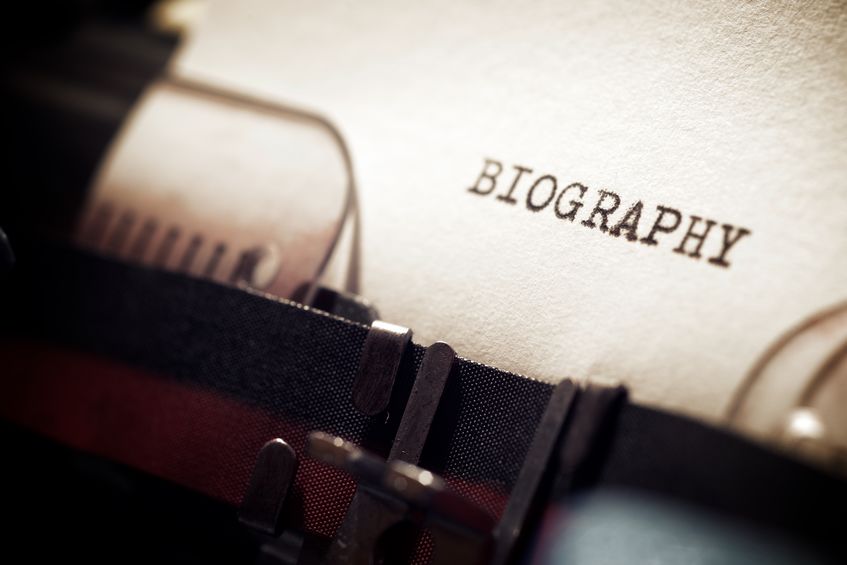
You might want to make short biographies for your characters for many reasons.
First and foremost, character bios help ensure that you have compelling, properly motivated, and consistent characters .
A frequent problem bad scripts encounter is a lack of consistency.
Motivations may flip without reason, the tone of a character may suddenly change, or the character might not make sense to the reader.
Even if you are writing a script inspired by real people, it’s important to make a bio that helps you remember their background, arc, and reasons for their decision-making.
Outside of simply helping you develop character, making these bios before starting your script can help with world-building .
If you’re writing a fictional script, writing out characters’ backgrounds and stories may help you find shared histories, relationships, and new locations to share.
In a non-fiction script, doing this can make clear certain parallels in the story.
This could help structure your story in terms of pacing and scene transitions.
It could also help you realize what is essential to include in the screenplay versus what might be interesting but unnecessary.
What Goes In A Character Bio
Any character you create can be complex. Even side characters can have full biographies, and doing this (though not always needed) may open you up to new ideas.
In your bio, there will be some givens.
Your character’s name, relationship to the story, and motivation/goal are hugely important.
However, this is not all that can be said.
It helps to think about what their background is. Where did they grow up?
What is their socio-economic background? How does their personality manifest to people around them, and does that differ from how they truly feel?
Other important things to note are relationships with other characters , significant others, work and home life, how they make decisions, morals, and ethics.
The number of questions you could ask is limitless, much of which stems from the story you’re trying to tell and their relation to that. Therefore, it is also important to include the character’s arc .
Will they change throughout the story? Will that change be external, internal, positive, or negative?
Since all these questions can get overwhelming, it helps to think about archetypes and ways we define character traits in the real world.
After all, these character bios should help make the writing process easier, not get in the way.
Tips And Tricks For Great Characters

A good way to avoid spending too much time on bios and getting overwhelmed is to use archetypes and ways of describing character traits that come up in the real world.
You shouldn’t adhere to these too strongly to avoid cliches, but they help fill in some gaps when you don’t want to think about everything.
In my writing, I like to think about the characters’ astrological signs . Often, these charts include many unique details that can bring out some interesting and specific traits.
Similar to this, the Myers-Briggs personality test gives detailed descriptions of a variety of personality traits. If you want to explore your character’s psyche , this is great to look into.
Other fun methods can come from a variety of popular media. If you’ve ever played role-playing games like Dungeons and Dragons, you can use the alignment system . Is your character lawful good, chaotic evil, or somewhere in between?
Or what house in Harry Potter would your character be a part of?
Check out the best Harry Potter quotes here .
These are quick ways to give your character a guiding philosophy, strong personality, and extra detail that can help whenever you ask, “What should this person do?”
Examples Of Character Bios
Plenty of templates exist for making character bios, ranging from something as simple as a few sentences describing essential traits to full-on graphics exploring a character’s inner complexities.
A quick Google search can give you plenty of ideas if you’re looking for something unique.
A fun way to create a character bio I’ve used is the Film Crit Hulk Character Tree . This asks seven tough questions matched to physical body parts that help to clarify your character’s motivation and worldview.
If you intend to use character bios in a film treatment or pitch , it helps keep things as simple as possible.
Sometimes, people like to separate likes and dislikes from the background.
Other folks like to focus on more physical characteristics.
Below is an example and template of a character bio format I have used on my projects.
Template For A Character Bio
Name: Ellie Browning
Occupation: Student
Gender: Female
Sexual Orientation: Straight
Alignment: Chaotic Good
Zodiac: Leo Sun, Sagittarius Rising, Aquarius Moon
Relationship/Role: The protagonist, a daughter, a granddaughter, a student
Background: Ellie Browning was born in Salem, Oregon, in 1999. She has lived there her whole life but dreams of leaving. Ellie’s mother, Jackie, disappeared in 2004 when she was five years old, and Ellie has lived with her Grandma Rose ever since. Their house is modest. Rose was an art teacher before she retired, which translated to Ellie’s passions. She frequently draws, hikes, and explores the woods nearby. She has been obsessed with why her mother left since she was five, which is the subject of most of her art.
Goal: Ellie has two main physical goals: to get out of Salem and to reunite with her mother. Emotionally, Ellie is lonely, and though she won’t admit it, she is also searching for a friend.
You can download an empty version of the movie character bio template here for free . All you need to do is fill in the blanks:
A character bio will often be presented along with a film treatment, logline , or story synopsis.
If not, you may want more detail on the story as you send it out, but ultimately, the structure and level of depth are up to you!
Character bios are flexible and depend as much on the character and story as they do on you as the writer.
It’s important to ask yourself pressing questions and allow those to guide the screenplay you’ll write.
If you ever struggle to get through a portion of your script, having bios for all your characters can give you enough information to push through to the end.
Detailed backgrounds are also a great way to surprise yourself with new ideas.
It’s hard to go wrong with making bios. It’s also great to experiment with templates and formats , so if you haven’t done a bio before, be sure to do some research and get creative.
Ultimately, the main goal of a character biography is to inspire you to write the best screenplay you can!
Have you made many character bios before? Do you want to include certain traits and details that we forgot above? Let us know in the comments below, and good luck with your next writing project!

Cade Taylor is a filmmaker and writer based out of Los Angeles. Originally from Seattle, he continues to work as the Outreach Coordinator for the Bigfoot Script Challenge, where he helps connect up-and-coming writers with industry professionals. When he’s not working on his own projects, helping out with Bigfoot, or covering desks, Cade loves to share what he knows with other filmmakers and promote great content.
Leave a Comment Cancel reply
This site uses Akismet to reduce spam. Learn how your comment data is processed .

Book your free, no obligation, online consultation today to begin your coaching journey today, and start booking the jobs you deserve. BOOK NOW.
- Aug 14, 2023
An Acting Coach's Guide To Creating A Character Biography (Complete with Template!)
Updated: Sep 9, 2023
Diving Deep into Character: Your Path to Crafting Character Biographies

Welcome to the realm where stories come alive, and characters breathe with a vitality that stirs the soul! I'm thrilled to have you on this journey of discovery, where we delve into the heart of crafting character bios that will not only provide you with a solid foundation as an actor but will ignite your process, letting your prowess shine for all to see.
As an acting coach, I am frequently asked where to begin when creating a character - and how to enhance your connection to that character, their actions and behaviours. I firmly believe that the character biography is where it all starts coming together. It's like a woolly jumper fraying at the seems: once you start pulling at it, it's hard to stop! It may sound like an obvious place to start, but you would be amazed by how many seasoned professionals skip the step. Remember, as an actor, 95% of your work is done in preparation - be that before you step on set, in front of a camera for a self-tape, or into a rehearsal room (way before the point of even stepping on stage!). This early - but vital - stage of the process combines your ability as a fact-finding dramatic detective mining into the details of the role with your capacity as an imaginative artist. It brings together your abilities to analyse and to create.
Let it gnaw at your soul. Let it become an obsession.

“If you are looking for something, don't go sit on the seashore and expect it to come and find you;
You must search, search, search with all the stubbornness in you”.
Constantin Stanislavski, Building A Character
The Heartbeat of Character Bios
Picture this: you're not just stepping into a role but into a life.
Understanding the character's building blocks can open up possibilities for you as the actor - and that begins with mining the text for facts. Finding facts and asking questions. You won't receive all of the facts every time, which sometimes leaves you with a longer list of questions and assumptions about the character, but the character biography is where this all comes together as you start to shape the story you will tell.
A well-crafted character bio isn't just a list of traits, it shouldn't just be a sterile process that feels like 'going through the motions'; it's the doorway to understanding the very essence of your character, and it must feel urgent, and it should inspire. Remember, if something isn't interesting to you, it will be all the more difficult to make playable - but be brave as you awaken your curiosity. How can you let even the most seemingly mundane of information spring to life and capture your imagination? A solid - and truly creative - character biography is the secret to unlocking a performance that transcends the ordinary and becomes extraordinary.

Helpful Hints and Tips:
Even if the fact or detail you find appears somewhat dry, find what playable possibility it opens up. Say the character was born in the 1980s. What does this open up for you to research, to surround yourself with? Think of images, sights, sounds, politics (anything that whets the appetite of the imagination). Let the mundane springboard you into more visceral, exciting territory that can awaken the imagination.
Unveiling the Elements of Enchantment
Remember, take nothing for granted. Every uncovered fact holds possibility. Crafting a character bio that captures the attention of the audience and the soul of the actor requires us to weave some essential elements:
Roots and Identity : Our characters, like us, are shaped by their past. Dive into their roots, their upbringing, and the cultural tapestry they hail from. This is the foundation on which their uniqueness stands. Some things will feel closer to you, and your own lived experience and other considerations will feel more like a leap, but no matter how close or far the character seems to be from you, you will need to engage in the act of transformation (both internal and external), so, be specific! Even when you transform, it will always be you: don't fear losing yourself, instead, be excited about what your unique perspective brings to the story.
Desires and Ambitions : Ah, aspirations! What fuels our characters' fire? What dreams do they chase with unyielding determination? Uncover the depths of their yearnings, their needs ... and their fears. What do they see in their mind's eye every night before they drift off to sleep?
Confrontations and Crucibles : Stories thrive on conflicts, both inner and outer. Our characters wrestle with fears, face dilemmas, and brave challenges. This is where their strength and vulnerabilities entwine. I always encourage actors to mine down as deeply into a character's fears as their dreams. It's always a useful tool to ask yourself, 'when do they feel fear?', as it frequently shapes our world and our actions to a far greater extent.
Connections That Bind : Life is an intricate web of relationships, and so is the world of storytelling. Map out the ties that define your character – friends, family, rivals – they all shape your character's narrative. Really mine down into the relationships they have in the play as we place great value in these. Don't limit it to those that we see them interact with. They might not mention their family, but this, in itself, is fascinating.
Riding the Emotional Waves : Emotions are the colours on an actor's palette. Understand what stirs your character's emotions – joy, sorrow, anger – and let those emotions surge through your performance. But, remember, we do not aim for emotion, as we cannot play it whilst remaining outwardly engaged. Ride the wave of them like an expert surfer, use them as your fuel; but, remember they are bi-products of action. Always focus on what you are doing, not what you are feeling!
Unearthing Backstories : Every character carries a history that whispers through their actions. Unearth the pivotal moments that paved the way for your character's present. This backstory is your treasure trove. Populate it with timelines and find sources to bring life to those 'memories' if you can. Collect sources to awaken the senses of the imagination. I always recommend visualising key life moments to fully submerge yourself in the imaginative world you are creating. If you can, why not even improvise key moments with your fellow actors so that you have a shared experience of these events? Some directors will factor this into the rehearsal process, but there's nothing to stop you from digging deeper should you wish.
When writing out statements pertaining to your character, try to write them out as simply that, statements. Don't just make it a cold list of facts. And always write them in the first person to make the distance of the transformative journey seem a little shorter!
Embarking on Your Character-Building Odyssey
Crafting a character bio shouldn't be a task; it's a voyage of self-discovery. And, whilst acting isn't therapy, this voyage of discovery will inescapably tell you more about yourself every time you undertake it. Here's your route:
Plunge into Research : Immerse yourself in the script's world. Feel its heartbeat. Understand the era, the place, and the ethos that cradle your character's journey - unlock what is known as the 'planes' of the text. Think about: eternal factors (the dramatic structure of the script, its main events and form); social situations (the historical, political and context-based information about the world); literary influences (the style of the writing, the genre); aesthetic considerations (the writer's chosen theatrical devices and the artistic vision for the production); psychological elements (the inner-workings of the character); physical components (external considerations for the character, and the actions they undertake); and personal creative feelings (your personal connection to the character and the play).
Interrogate and Reflect : Each section of our character bio template is a portal. As you answer, question your character's motives and choices. Reflect on their essence and fill them out to make them tangible. Again, collect sources that this springboard takes you to, and ensure that you engage all the senses of the imagination. Every actor will have a preference over what source material stirs and moves them, and the more you engage with your craft and the process, the more you will understand what works for you and what transports you. Be prepared that this may shift based on the needs of the project - and as you grow as an artist, so don't take anything for granted. Beware of declaring that you know your process and being limited by it: it is always shifting and changing like you.
Unearth the Depths : Look beyond the surface. Unearth the hidden gems in your character's psyche. How do their experiences shape them? What sets them apart?
Polish Your Gem : Just like a diamond in the rough, your character bio needs refining. Fine-tune the facets until they sparkle harmoniously with your character's soul. And, remember, sometimes frustratingly so, the work never ends when dealing with a fully rounded character: there's always more to know, more to discover. Watch out for patterns and repetitions, they always signify something substantial to unlock in your character.
Seek the Wisdom of the Wise : Don't hesitate to tap into the wellspring of wisdom that seasoned mentors and coaches like myself provide. Their insights can reshape your perspective and offer new obstacles to rejuvenate your process and breathe new life into your craft.
Constructing a timeline of events in the play - and for your character - based on the discoveries you make whilst reading the play, will set you in good stead as you grow your character biography. I always advise formulating a list of facts and questions from the play first before embarking on fleshing out the character's world. Some also find it helpful to complete character lists too before committing to a character biography (a list of things the character says about themselves, another containing what they say about others, and a final list about what other characters say about them).
Let the art of character bio creation be your portal to a world of authentic, vivid, and unforgettable storytelling. It is the departure point for you to breathe life into your performances and carve a path toward dynamic choices and bold portrayals.
The attached character biography template should be a starting point.
Download Your Character Biography Template Here
Download it, use it, explore it. But, most importantly, modify it, grow it and adapt it as your process sophisticates and new questions arise with each project you dance with.
Wanting To Dig A Little Deeper?
If you are looking to delve deeper into the journey of developing a character, be sure to give these books a once over. They will be a welcome addition to your bookcase!

Don't forget to check out the other books recommended by RDD Coaching to help you grow your craft and develop your process. You can find the resources page here .
Unleash Your Potential with Richard Delaney's Coaching Sessions
Remember, every character you embody, much like you, carries a story worth sharing. Ready to take this work to the next level? Let RDD Coaching enhance your ability to create fully-rounded and dynamic characters by awakening your curiosity, adding layers that you never knew existed. Explore ways to breathe life into the stories you tell, honouring your artistic voice and getting you noticed!
All new clients are entitled to a free online consultation before committing to their training journey. Coaching sessions can take place in a variety of settings to work with your availability, budget and requirements. For more information on available coaching packages, check out Richard's coaching pages here .
Recent Posts
Practicing self-belief in these turbulent times: Placing process over product
Acting coach Richard Delaney: ‘Engage with failure and take bigger risks’
Offies Nominations For Secret Life Of Humans
Character Generator
Create a detailed character profile.
Generate a detailed profile for a realistic and rounded character. Output loads of detail including a biography, information about the important people in your character's life, and a timeline. Ideal for your protagonist or characters in a long novel or epic film series.
A Few Keywords About the Character
(Otherwise leave blank.)
Please wait a moment.
- Snappy One-Liner
- Freestyle Biography
- Basic Information Table
- Personality Details
- Employment History
- Relationships
- Political Views
Use our characters as they come or as inspiration for your own.
Detailed Character Profile Generator
detailed character generator / random character creator / random OC generator / OC creator

On Creating Characters
Learn Screenwriting
- How to Format a Screenplay
- How To Outline A Screenplay
- Creating Characters In Your Screenplay
- How to Write Better Descriptions
- Screenplay, Stageplay, Teleplay: What’s The Difference?
- The Secret To The First Ten Pages In Your Screenplay
Crafting character is one of the most important elements of screenwriting. When you think about your favorite movies and TV shows, what probably stands out for you even more than the plot or story is the characters that inhabit that world. Strong, compelling characters can elevate your screenplay and attract actors and directors to your material. But how do you ensure that your characters are rich, three dimensional beings with thoughts, emotions and desires? How do you make sure they behave in ways that are consistent to who they are within your story?
There are many ways to approach writing character. Some writers mull over their characters for a long period of time, then when they feel they “know” them, jump in and start writing. Some writers list the major elements of their character’s lives on Index Cards; others write extensive character histories or draw diagrams of their behavior. Some use pictures and photographs to help them see what their characters look like. They may tack the pictures above their work area so they can “be with” their characters while writing. Another popular method to help visualize your character is to use actors and actresses as models. Many actors are well known for playing particular character types, so it may help you to visualize a certain actor who is popular in the genre of movie that you are writing.
One of the most insightful character tools you can use is writing a Character Biography. The character biography is a writing exercise that reveals your character’s history from birth up until the time your story begins. It captures and defines the forces—both physical and emotional, internal and external—working on your character during those formative years that fashioned their behavior. It is a process that reveals what made them who they are.
Start at the beginning. How old is your character when the story begins? Where do they live? What city or country? Where were they born? Were they an only child, or did they have any siblings? What kind of relationship did they have with their family? What kind of childhood would you say your character had? Would you consider it happy? Was it physically or medically challenging, with illness or physical problems? How does their childhood inform who they are when your story begins?
Do the same with the professional, personal, and private life of your character in the present. What does your character do for a living? What relationships are important in their lives? What are their hobbies? You might even go into a “day in the life” of your character and write what their day looks like. What do they do from the moment they get out of bed to the moment they go to sleep at night?
Not only should you know everything about your characters and their inner lives, you should also know how they feel about and relate to each other. Are they friends or enemies? Will the events of the story turn them from enemies into friends, or vice versa? Do they keep secrets from one another? Do they have an unspoken past between them?
You can never put too much information in a character biography. Even if the information never appears in your actual screenplay, the fact that you know the ins and outs of your character’s lives will inform your writing every step of the way.
It’s your script, your story, your characters, and your dramatic choices. When you have completed your Character Biography, you will know your characters as if they were good friends.
Creating Character Biographies in Final Draft
Final Draft contains outlining tools that help you create Character Biographies with ease. Final Draft’s Beat Board is a section within your screenplay document where you can store all of your inspiration, ideas and roadmaps, including information on all your characters. You can even add images to the Beat Board, so you can store pictures of the people and actors who inspire your characters and who they are.
To explore Final Draft’s outlining features, click here.

Creating Character
October 23, 2014.
Creating character is a process that will be with you from the beginning to the end, from fade in to fade out. It is an ongoing educational progression, an experience that continues expanding as you go deeper and deeper into your characters’ lives.
Anything that makes it easier for you to create your character is a good tool. Choose your own way. You can use some, all, or none of the tools mentioned here. It doesn’t matter. What matters is whether it works. If it works, use it; if it doesn’t, don’t. Find your own way, your own style in creating character. The important thing is that it’s got to work for you.
One of the most insightful character tools is writing a Character Biography. The character biography is a free–association, automatic-writing exercise that reveals your character’s history from birth up until the time your story begins. It captures and defines the forces—both physical and emotional, internal and external—working on your character during those formative years that fashioned his or her behavior. It is a process that reveals character.
Start at the beginning. Is your character male or female? How old is he when the story begins? Where does he live? What city or country? Where was she born? Was she an only child, or did she have any brothers and sisters? What kind of relationship did she have with her brothers and sisters? Was it good or bad? Confiding or adventurous? What kind of childhood would you say your character had? Would you consider it happy? Or sad? Was it physically or medically challenging, with illness or physical problems?
What about her relationship to her parents? Was she a mischievous child getting into a lot of trouble or was she quiet and withdrawn, preferring her own inner life instead of a social one? Was she stubborn, willful and did she have a problem with authority? Do you think she was socially active, made friends easily, and got along well with relatives and other children? What kind of a child would you say she was? Was she outgoing and extroverted or shy and studious, an introvert? Let your imagination guide you.
THE EXERCISE
Write character biographies for two or three of your main characters in about seven to 10 pages. More if you need to. Focus on their early years. Where was the character born? What did his/her father and mother do for a living? What is his relationship with his parents? Does he or she have any brothers or sisters? What’s the relationship—friendly and supportive or angry and combative?
Define the other relationships the character has in his or her second and third 10 years and see how these relationships formed his or her character. Remember Henry James’ Theory of Illumination: Every character sheds light on your main character.
Before you begin writing your biography, think about your character(s) for a few days, then set aside a time where you can work two or three hours without interruption. No phone calls, no TV, no e-mail, videogames, no visits from friends. It may help to lower the lights or turn on some soft music. Then start “throwing down” thoughts, words, and ideas about the character. Just let it come out. Don’t worry about grammar, punctuation, spelling, or bad writing. Just get your thoughts down on paper, and don’t worry about anything else. You’re not going to show these pages to anyone; it’s only a tool for you to use while you discover your characters and “get to know them.” If you want to include parts of your character biography in your screenplay, fine. But just get your character down on paper. Free-associate. Let your characters discover who they are.
Do the same with the professional, personal, and private lives of your character. Write a page or two about what your character does for a living, his or her relationships and hobbies. You might even go into “day in the life” of your character and write what his or her day looks like? What does she do from the moment she gets out of bed till she goes to sleep at night? Write it in a page or two. If you need to write more, write more. If you can do it in less, do it in less.
If you discover any areas in a character’s life you feel unsure or insecure about, write it in a page or two. Do some research if necessary. Free-associate. The relationship between you and your characters is like the relationship between two best friends. You decide what you need then define it.
If you don’t know whether you should write something or not, write it! It’s your script, your story, your characters, and your dramatic choices. When you have completed your assignment, you will know your characters as if they were good friends.
Written by: Kala Guess
- Screenwriting
- Story Structure
Final Draft 13
Use what the pros use!

What’s new in Final Draft 13?
Writing goals & productivity stats.
Set goals and get valuable insights to take your work to the next level
A new typewriter-like view option improves your focus
Craft more realistic onscreen text exchanges and make your notes more emotive
And so much more, thoughtfully designed to help unleash your creativity.

Final Draft is used by 95% of film and television productions
You May Also Like
Professional Bio Generator
Transform your professional narrative into a compelling bio with ease. The AI-powered Professional Bio Generator will help you highlight your unique career journey in a tailored way that’s both true to your experience and aligned with the position you’re writing it for.

Craft a Meaningful Professional Narrative

Tailor Your Bio for Networking Opportunities
Our Professional Bio Generator crafts bios that open doors. Whether you’re networking on LinkedIn or a professional conference, create a biography that highlights your achievements and expertise in a holistic manner, resonating with industry leaders and peers alike.

Enhance Your Professional Presence Online
Whether it’s for a professional networking site, your personal blog, or a speaker biography, or your resume, our Professional Bio Generator provides you with a bio that's not just informative but also engaging and well pitched to your audience. Make every word count to leave an impression.

Differentiate Your Bio to Enhance Your Job Applications
Elevate your job applications by attaching a professional bio that complements your resume. Our AI-driven generator helps articulate your career narrative, aligning your professional experience with the target job's responsibilities and requirements.
Streamline Your Professional Narrative with AI

In the fast-paced job market, your professional bio is your personal brand’s elevator pitch—it needs to be sharp, engaging, and memorable. However, distilling a multifaceted career into a few compelling paragraphs poses a significant challenge, especially when balancing authenticity with the need to appeal to a diverse audience.
The Professional Bio Generator transforms your career highlights into a polished, professional bio quickly and efficiently. Tailored to your unique experiences and aimed at your target audience—whether potential employers, clients, or professional peers.
Designed with job seekers in mind, the tool ensures your bio is not only a reflection of your achievements but also a strategic tool to open doors to new opportunities. It saves you time while providing a customizable platform to fine-tune your professional story.
How to Use the Professional Bio Generator
Import your linkedin profile or resume.
To generate a quality bio that’s tailored to your career, the first step is to provide some information.
You can quickly import your resume or LinkedIn profile to draft a career outline using our visual interface. The more detailed your career input, the richer and more personalized your professional bio will be.

Highlight Your Career Achievements
To ensure your professional bio stands out and captures the most impactful aspects of your career, it’s crucial to highlight significant achievements across your experiences.
Add 1-2 key achievements for each of your recent roles. Where possible, incorporate metrics to quantify your achievements.
Tailor Your Bio for Your Audience
With your achievements listed, use our AI to generate a professional bio tailored not just to your career history but also to your future aspirations.
Whether you’re targeting a specific job role or crafting a general professional narrative, our tool adapts your bio to suit your objectives.

Review and Perfect Your Professional Bio
Review the AI-generated bio and make any desired tweaks to perfect your narrative. Our platform allows you to adjust and refine your bio, ensuring it truly reflects your professional persona and aspirations.
Once satisfied, your compelling professional bio is ready to be showcased across professional networks, personal websites, or job applications.
What's Free & What's
- Unlimited Resumes
- Unlimited Resumes Templates
- Unlimited Job Tracking
- Top 5 Keywords
- 1 Email Template Per job stage
- Limited AI Usage for Resume Achievements (5), Professional Summaries (2) and Cover Letter (1)
- Basic analysis in the resume builder
- Basic Resume Keyword Matching
- Everything in Teal Free
- Unlimited Advanced Resume Analysis
- Unlimited Resume Keyword Matching
- Unlimited AI Usage for Resume Achievements, Professional Summaries and Cover Letter
- Unlimited keywords (hard and soft skills) listed in the job tracker
- Unlimited Email Templates
- No ads across the entire platform
- 24/7 Email Support
Frequently Asked Questions
Yes, our Professional Bio Generator is equipped to craft your professional story to suit various contexts, from job applications to speaking engagements.
By inputting specific details and objectives, the AI customizes your bio to ensure it resonates with your intended audience.
Our tool utilizes AI to analyze your career achievements and skills based on the information provided in your resume or LinkedIn profile.
It then crafts a professional bio that highlights your career journey and accomplishments, making sure it aligns with your professional goals and the narrative you wish to present.
To make your professional bio stand out, provide detailed and specific career achievements when using the generator.
The AI will use this information to highlight your unique skills and experiences. Additionally, personalizing your bio for specific roles or audiences can further differentiate your profile.
Absolutely! After the AI generates your professional bio, you have full flexibility to edit and refine it within our platform. This ensures you can tweak any details, adjust the tone, and personalize it further to perfectly match your professional image and goals.
Better Resume. Faster Search. More Offers.

IMAGES
VIDEO
COMMENTS
Level Up Your Team. See why leading organizations rely on MasterClass for learning & development. Whether you're a screenwriter, novelist, or short story writer, using a character bio template can help you create vibrant, believable characters for your narrative.
A character bio, also known as a character profile or character biography, is a brief overview of your character that you can provide to others prior to the start of a game or roleplay. It gives them an introduction to your character before the narrative actually begins, which makes it easier to create plots and interact between characters.
The best character template to help you include traits you would never consider. Even expert OC designers can't figure out all the details without some prompting! ... On CharacterHub, you can create detailed character profiles, build worlds, share your art, and collaborate with a vibrant community of creators just like you. ...
A character bio is a document or template that outlines the biography of a character in a story. Commonly used in the form of a character sheet template, which includes in-depth questions that highlight the character's traits, descriptions, and journey, the character bio is used as a resource for the writer's reference.
1. Construct the character's outer appearance. To be able to identify a criminal, detectives build a painstakingly thorough file of said criminal's physical characteristics. That's the goal of this section, which covers the "skin" of your character: everything from their outer appearance to the way that they speak.
Use our character bio template to create authentic and real characters. The template includes 73 questions and characteristics to shape your characters. ... So, creating a character biography is quite important and will help you to build your story. Of course, you want to start writing. But take this break and start by defining the attributes ...
A character biography is a reference sheet that tells you everything you might need to know about your character, for any scene that you write. A character bio includes information on your character's background, personality, day-to-day life, appearance, and more. ... However, it's advisable to create character bios for all of your main ...
Just Think AI Prompts for Character Bio Templates. When requesting a character bio template from Just Think AI, provide: Character details - name, age, descriptors, abilities etc. Genre and setting the character exists within. Character role in the story. Any special attributes or details about the character. Supplying this context allows Just ...
Step 1: Open Plottr and start a new project (or open an existing one) Step 2: Once the project is open, navigate to the Characters tab and click the + button to create a new character (or edit an existing one), then click +Add Template. Step 3: Select Character Bio from the list of character templates and click Choose to add it to your ...
Only the first two sections of the character bio template/checklist (1. Summary and 2. Tags & Quirks) are needed for most characters. Delve deeper (elements 3 through 10) for just a few key characters. Don't fill out a "form" about your character.
A character bio, or character profile, is a few sentences or pages that make up your character's story. They help embellish your character's traits and aid in character development and mapping out your character's arc. The bio should give the person reading it a way to personally connect with the character. It should not matter whether or not ...
A character bio template acts as a roadmap or a guide to creating a bio for your characters. It gives you a checklist of the things you need to add as part of your characters for them to develop naturally through the course of the story. Writing a character bio is a good exercise for writers because it forces them to think about what makes a ...
This generator collects a few words from you and embellishes them to create a rich character. The resulting biography is written in free text rather than confined to tables and charts. Depending on the age of the character, we'll generate 4-8 paragraphs of text about him or her. This is ideal for quick inspiration or for creating portfolio's of ...
A character bio (also called a character template or character profile) is a document used to organize everything you know about a character, from their family background to their favorite flavor ...
Write a scene from their perspective. Draw or describe their house in detail. "Interview" your character, answering questions in their voice. Write their resume. Write a few journal entries in their voice. Ask to shadow someone who has the same job or hobbies your character has. Go interview someone with similar experiences.
2. Physical appearance and characteristics. Well-defined physical characteristics help readers visualize your character, making a more engaging and immersive reading experience. Consider: Build/stature. Height. Hair and eye color. Ethnicity. Clothes/style.
All you need to do is fill in the blanks: Free-character-bio-template Download. A character bio will often be presented along with a film treatment, logline, or story synopsis. If not, you may want more detail on the story as you send it out, but ultimately, the structure and level of depth are up to you!
A solid - and truly creative - character biography is the secret to unlocking a performance that transcends the ordinary and becomes extraordinary. Helpful Hints and Tips: Even if the fact or detail you find appears somewhat dry, find what playable possibility it opens up. Say the character was born in the 1980s.
Our character bio generator will create compelling backstories for any type of character in mere seconds. Here's what you need to do to generate a character biography with our tool: 1. Insert your character's name and other details you've come up with, such as occupation, aspirations, or age. 2. Select a genre. 3.
Create a Detailed Character Profile. Generate a detailed profile for a realistic and rounded character. Output loads of detail including a biography, information about the important people in your character's life, and a timeline. Ideal for your protagonist or characters in a long novel or epic film series. Please keep your input family friendly.
Final Draft contains outlining tools that help you create Character Biographies with ease. Final Draft's Beat Board is a section within your screenplay document where you can store all of your inspiration, ideas and roadmaps, including information on all your characters. You can even add images to the Beat Board, so you can store pictures of ...
Others create an elaborate list of characterizations. Some writers list the major elements of their character's life on 3 x 5 cards; some write extensive outlines or draw diagrams of behavior. ... The character biography is a free-association, automatic-writing exercise that reveals your character's history from birth up until the time ...
Simplify your job search and land your next position sooner with Teal's all-in-one suite of tools. Transform your professional narrative into a compelling bio with ease. The AI-powered Professional Bio Generator will help you highlight your unique career journey in a tailored way that's both true to your experience and aligned with the ...